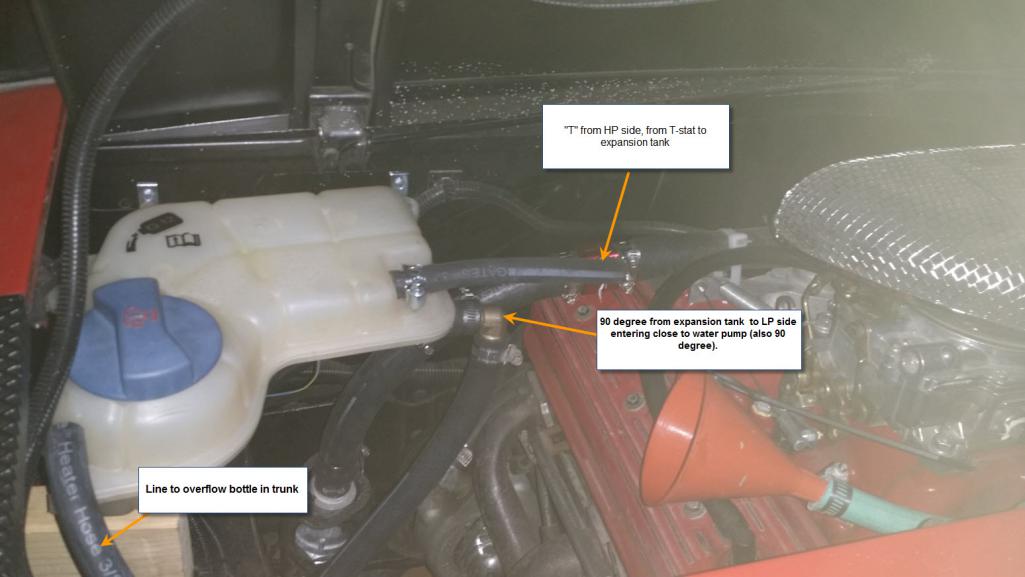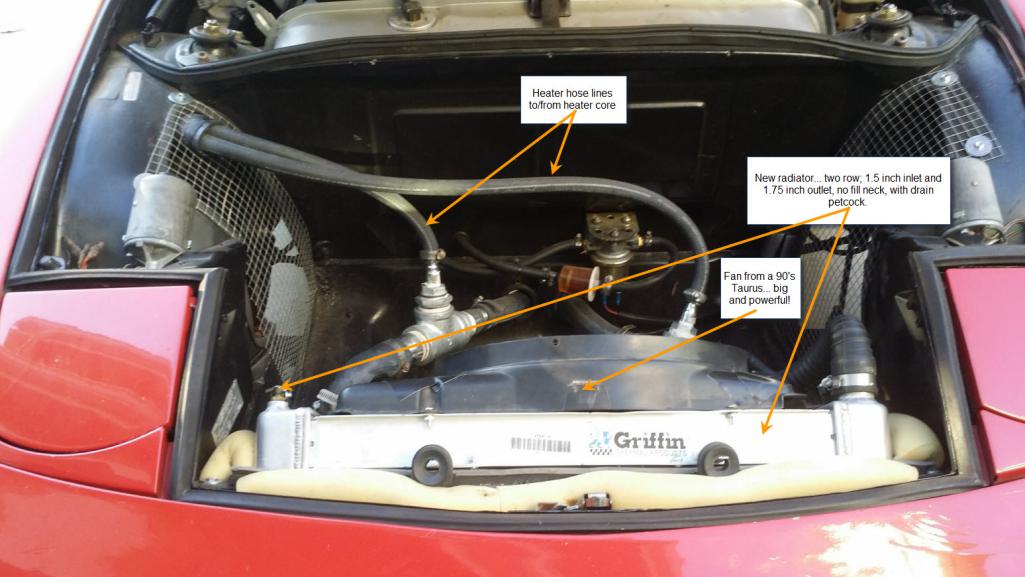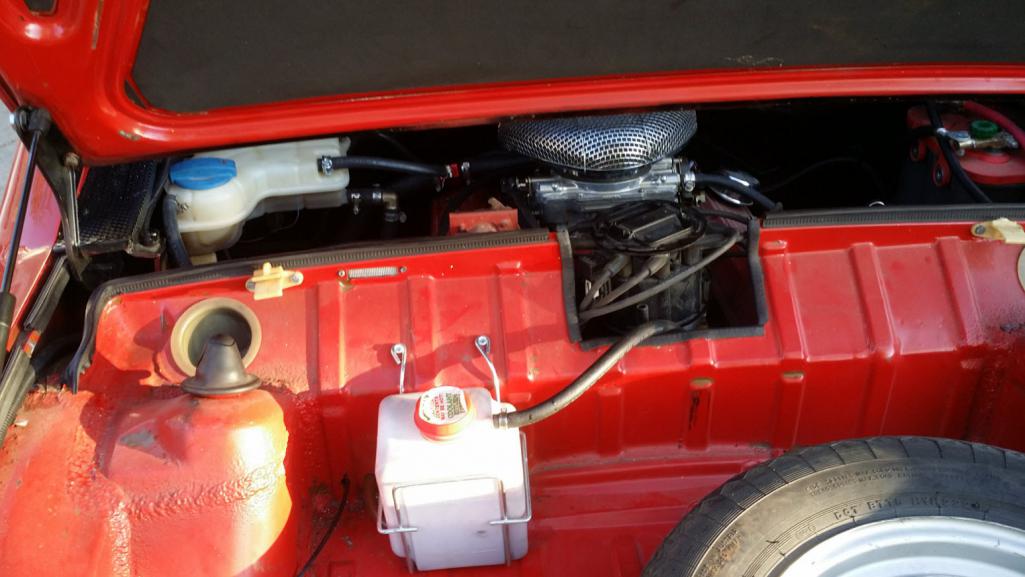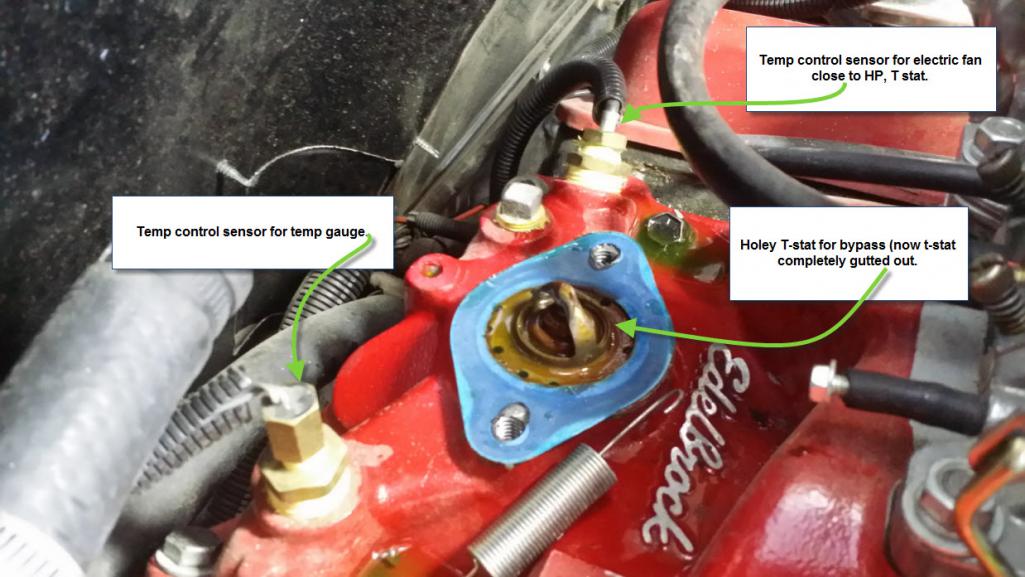Printable Version of Topic
Click here to view this topic in its original format
914World.com _ 914World Garage _ The best location for an electric water pump SBC V8 conversion
Posted by: BRAVE_HELIOS Apr 22 2017, 10:06 AM
Hey all,
Inching closer to going electric on my V8 conversion car. Right now; going through the process of cleaning out radiator and water passages/block with ThermoCure, then Prestone citric acid flush. Assuming I get a really clean system but not fix the run hot situation; I will go electric. Where is the best place to mount the electric pump? It would seem that the easiest way to go in my case is with this:
http://www.jegs.com/i/JEGS-Performance-Products/555/50930/10002/-1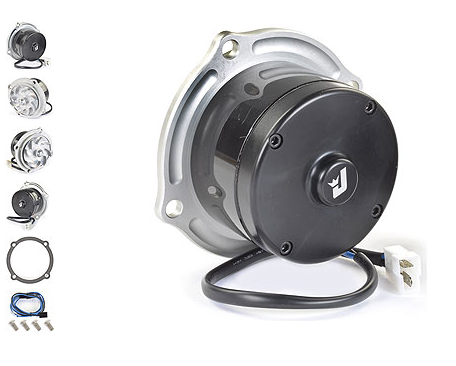
It a 50 GPM unit that should bolt right up to the Renegade remote water pump housing already in place in my car on the lower left hand side of the engine... that is assuming there is enough clearance between the water pump and the firewall.
Would this work? I have heard stories going back and forth about mounting the pump by the radiator or by the engine.
Posted by: 914GT Apr 22 2017, 12:53 PM
Best location is the lowest point in the cooling system and at the rear (below engine). During acceleration the suction side of the pump will have highest pressure and helps the pump when you need maximum flow.
Posted by: BRAVE_HELIOS Apr 22 2017, 01:38 PM
Best location is the lowest point in the cooling system and at the rear (below engine). During acceleration the suction side of the pump will have highest pressure and helps the pump when you need maximum flow.
So then my idea of using the Jegs pump and mounting it the Renegade remote water pump housing is a good idea (as long as clearance allows)?
Posted by: BRAVE_HELIOS Apr 22 2017, 02:13 PM
As a side note... I just took the car for a short drive; still with the Prestone Radiatior Flush and Cleaner running through the cooling system. I'm doing the heavy duty cycle cleaning... 3-6 hours of 'normal' driving. Of course, always with an eye on the temp gauge. Anyway; today after getting back from my short drive, I noticed that the overflow bottle in the trunk was actually bulging quite a bit. There is no pressure cap on it, just a simple snap type cap, yet it was definitely looking like it was under pressure. Temp gauge read around 180 and the electric fan was running.
Is this normal? Sometimes I wonder if I have the expansion tank plumbed correctly. Can you tell by looking at the pictures and descriptions that it is installed correctly?
Posted by: BRAVE_HELIOS Apr 22 2017, 03:25 PM
These custom fabricated cars... you sometimes just don't know how to apply standard processes.
Case in point; Along with the Prestone Radiator Flush and Cleaner liquid, I purchased their Flush and Fill Kit, complete with T's, clamps and Back Flow Preventor Coupler. Thing is, how do I install it on my car? Directions say to install T on inlet side of the heater (core) in order to allow back flushing. In my case, my coolant flows as such; I tapped into the inlet hose of the radiator to take coolant to the heater core then tapped into the radiator outlet hose to take the coolant away from the heater core and back to the water pump.
Would I still follow the directions on the Fill and Flush kit to allow back flushing? It would seem to me if water from the garden hose was flowing back towards the engine via the radiator inlet hose, that when the engine was running withe the garden hose also running water, the pump flow/direction and garden hose flow/direction would work against each other. The instructions state to keep the pressure cap off and perhaps that is where the pressures and flows would cancel each other?
Perhaps another approach would be... what is the best way to back flush the system in my car and with this setup?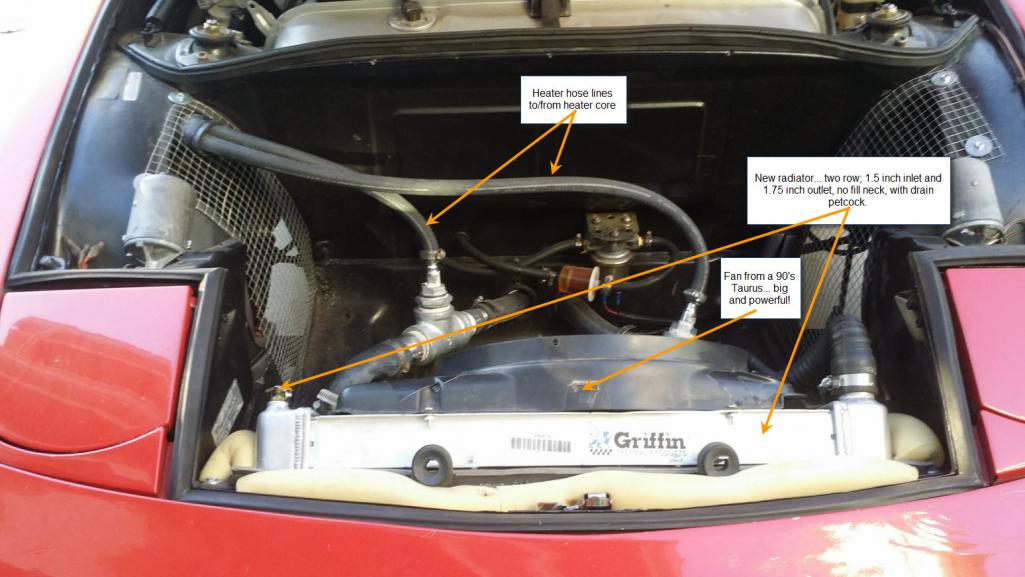
Posted by: Mike Bellis Apr 22 2017, 03:39 PM
I have heard of those electric pumps bottoming out in the housing and binding the impeller. Make sure to check for this. I do think it's your best be/easiest install.
If you are talking about the bottle in the trunk bubbling, that hose should connect to a filler cap vent. Should be no pressure unless your cap has failed.
Posted by: Andyrew Apr 22 2017, 04:25 PM
I have heard of those electric pumps bottoming out in the housing and binding the impeller. Make sure to check for this. I do think it's your best be/easiest install.
Even the mopar pumps do that. I had to clearance my old rebuilt mopar pump for the impeller.
Posted by: bulitt Apr 22 2017, 04:40 PM
Lots of threads on this topic...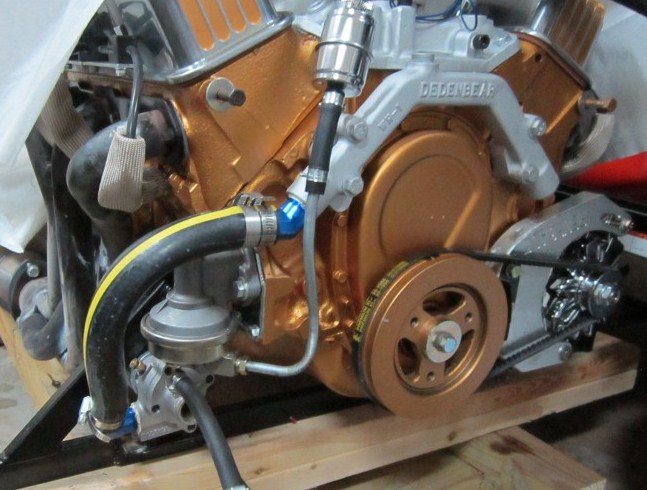
Posted by: BRAVE_HELIOS Apr 22 2017, 04:44 PM
I have heard of those electric pumps bottoming out in the housing and binding the impeller. Make sure to check for this. I do think it's your best be/easiest install.
Even the mopar pumps do that. I had to clearance my old rebuilt mopar pump for the impeller.
I was about to ask... if the Jegs unit is made to install in a stock MOPAR W/P housing and I (we) have stock MOPAR mechanical W/P installed in the Renegade Remote W/P housing, how could they not either be interchangeable (both work correctly) or both have the same potential clearance issues.
How does one check for clearance anyway?
Posted by: BRAVE_HELIOS Apr 22 2017, 04:46 PM
Lots of threads on this topic...

Oh yes; I know and it's still very confusing... perhaps too much info out there.
I am looking for the most up-to-date info y'all have!
Posted by: 914GT Apr 22 2017, 05:10 PM
An expansion tank and overflow tank are different things. The expansion tank is pressurized and should be the highest point in your system, usually above the thermostat. The radiator cap is on this tank and it opens to purge out trapped air and coolant to the recovery tank.
I use a Dendenbear remote pump and water header like shown in the picture above. I don't know about the pump you are using but it should be probably be bench tested to make sure there's no interference with the impeller. With these electric pumps it's recommended not to use any teflon thread tape and also be careful that excess Permatex or sealants do not get into the impeller that could jam it up.
Posted by: BRAVE_HELIOS Apr 22 2017, 05:22 PM
An expansion tank and overflow tank are different things. The expansion tank is pressurized and should be the highest point in your system, usually above the thermostat. The radiator cap is on this tank and it opens to purge out trapped air and coolant to the recovery tank.
I use a Dendenbear remote pump and water header like shown in the picture above. I don't know about the pump you are using but it should be probably be bench tested to make sure there's no interference with the impeller. With these electric pumps it's recommended not to use any teflon thread tape and also be careful that excess Permatex or sealants do not get into the impeller that could jam it up.
My expansion tank (VW Passat unit with pressure cap) is mounted above the T-stat. Pressure cap is new. Please note picture with descriptions as to which ports on the expansion tank go to where. I am pretty sure it is plumbed correctly. Not sure about the 90 degree elbows used for clearance and so rubber hoses will not kink.
Does the Dendenbear unit allow for coolant bypass when cold? Mine is a Renegade kit, therefore it has two separate ports and hoses going to those inlets.
I see... mount the pump in the housing and rotate to check for metal to metal sounds etc...
Posted by: Andyrew Apr 22 2017, 05:29 PM
I have heard of those electric pumps bottoming out in the housing and binding the impeller. Make sure to check for this. I do think it's your best be/easiest install.
Even the mopar pumps do that. I had to clearance my old rebuilt mopar pump for the impeller.
I was about to ask... if the Jegs unit is made to install in a stock MOPAR W/P housing and I (we) have stock MOPAR mechanical W/P installed in the Renegade Remote W/P housing, how could they not either be interchangeable (both work correctly) or both have the same potential clearance issues.
How does one check for clearance anyway?
Check for clearance by installing it and seeing if it spins freely. If its difficult to bolt down tight then there is another sign.
Posted by: BRAVE_HELIOS Apr 22 2017, 05:33 PM
I have heard of those electric pumps bottoming out in the housing and binding the impeller. Make sure to check for this. I do think it's your best be/easiest install.
Even the mopar pumps do that. I had to clearance my old rebuilt mopar pump for the impeller.
I was about to ask... if the Jegs unit is made to install in a stock MOPAR W/P housing and I (we) have stock MOPAR mechanical W/P installed in the Renegade Remote W/P housing, how could they not either be interchangeable (both work correctly) or both have the same potential clearance issues.
How does one check for clearance anyway?
Check for clearance by installing it and seeing if it spins freely. If its difficult to bolt down tight then there is another sign.
Ok. So the idea of going with the Jegs units that mounts in the Renegade housing sounds viable? I'm sure I can file/grind at least some material off the housing for clearance without it being detrimental to either the housing or the pump; yes?
Posted by: Andyrew Apr 22 2017, 05:46 PM
Seems like it was designed to be used as a replacement of the Mopar belt driven pump so yes I think it would make perfect sense in this application.
Scroll down and you can see the issue I had with the rebuilt pump I had.
http://www.914world.com/bbs2/index.php?showtopic=114780&st=20
Posted by: BIGKAT_83 Apr 22 2017, 05:47 PM
I hope you have the hose from the header tank going to bottom of the recovery tank. I cant see it in your pictures. If its going to the top as it looks like there is no way for the water to get sucked back into the system.
I have a Meziere 316 55gpm remote pump I could send you to try. I would be a little harder to plump up but might save you from buying something you don't need.
Posted by: 914GT Apr 22 2017, 05:51 PM
It's not clear to me where the radiator pressure cap is. I guess the Passat tank looks more like a coolant recovery tank to me. None of the remote water pumps, electric or mechanical, are going to have a bypass like the stock pump has. You'd need a pump that mates to the holes on the block, which means modifying the firewall for clearance to the pump. I have an external bypass incorporated into my heater hose connections to give some coolant flow when the thermostat is closed. I found that the bypass keeps the engine cooler because it allows coolant to circulate in the block and heads until the thermostat needs to open up.
Posted by: BRAVE_HELIOS Apr 22 2017, 06:10 PM
I hope you have the hose from the header tank going to bottom of the recovery tank. I cant see it in your pictures. If its going to the top as it looks like there is no way for the water to get sucked back into the system.
I have a Meziere 316 55gpm remote pump I could send you to try. I would be a little harder to plump up but might save you from buying something you don't need.
Thanks... I may take you up on the offer. I am so afraid that I will spend the money on an electric unit just to find out it is some other issue. That's why I am now cleaning out the system the best I can (without removing the engine) to see if this makes a difference. I just have had no luck with making this car remain running at a decent temp (like 180-200). I also now know to elevate the front of the car so the petcock located on the top right of the radiator can be used to bleed the system. I use a slightly modified vacuum brake fluid bleeder like this one and it works really well in helping me bleed the system.
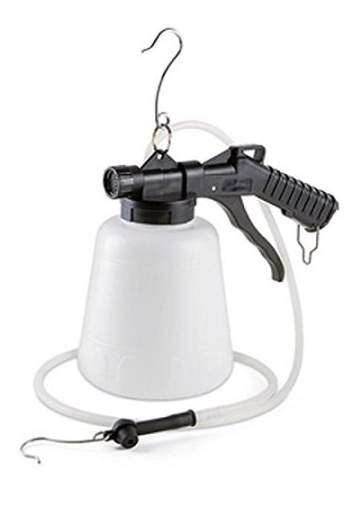
As for the Passat header tank (I call expansion/ tank) overflow line, it does connect to the bottom of the recovery (I call overflow) tank. The recovery tank overflow line used to vent to the ground but I now have it going into another smaller bottle located at a lower point in the engine bay by the trunk bulkhead. There may be some sort of blockage there causing the header tank to build pressure. I will check it out.
Posted by: BRAVE_HELIOS Apr 22 2017, 06:15 PM
It's not clear to me where the radiator pressure cap is. I guess the Passat tank looks more like a coolant recovery tank to me. None of the remote water pumps, electric or mechanical, are going to have a bypass like the stock pump has. You'd need a pump that mates to the holes on the block, which means modifying the firewall for clearance to the pump. I have an external bypass incorporated into my heater hose connections to give some coolant flow when the thermostat is closed. I found that the bypass keeps the engine cooler because it allows coolant to circulate in the block and heads until the thermostat needs to open up.
Yes, the VW expansion tanks utilize a pressure cap, although they are a bit problematic especially when trying to connect a pressurizing tool like the ones you can rent from your local FLAPS. I had to make an adapter in order to be able to use it.
Posted by: BRAVE_HELIOS Apr 22 2017, 06:23 PM
I hope you have the hose from the header tank going to bottom of the recovery tank. I cant see it in your pictures. If its going to the top as it looks like there is no way for the water to get sucked back into the system.
I have a Meziere 316 55gpm remote pump I could send you to try. I would be a little harder to plump up but might save you from buying something you don't need.
Thanks... I may take you up on the offer. I am so afraid that I will spend the money on an electric unit just to find out it is some other issue. That's why I am now cleaning out the system the best I can (without removing the engine) to see if this makes a difference. I just have had no luck with making this car remain running at a decent temp (like 180-200). I also now know to elevate the front of the car so the petcock located on the top right of the radiator can be used to bleed the system. I use a slightly modified vacuum brake fluid bleeder like this one and it works really well in helping me bleed the system.

As for the Passat header tank (I call expansion/ tank) overflow line, it does connect to the bottom of the recovery (I call overflow) tank. The recovery tank overflow line used to vent to the ground but I now have it going into another smaller bottle located at a lower point in the engine bay by the trunk bulkhead. There may be some sort of blockage there causing the header tank to build pressure. I will check it out.
I may have neglected to mention something because I just installed it and am waiting for the results.
In the Bible V8 Conversion Book; there is one small paragraph that mentions KEP recommending the use of a restrictor washer located at the inlet of the radiator. I installed one with a 3/4 inch diameter (the inlet size of the rad is 1.5 inch). Also the T-stat has been gutted so no restriction there.
I have pretty much tried every iteration I can think of... T-stat in, T-stat out, restrictor washer out, restrictor washer in, expansion tank out, expansion tank in. The only thing I have not tried is the electric water pump.
What I do not understand is if the mechanical pumps are not efficient enough to work in this application (V8 914) then why offer them?
Posted by: 914GT Apr 22 2017, 07:00 PM
I never thought the restrictor washer was necessary. I understand the thinking behind it, such as raise the pressure on the line to the radiator to either prevent steam bubbles or reduce the flow so the radiator has more time to cool. Some of this is based on old fixes going back to the 1950s.
I'd make sure you have all the air out of the radiator and hoses at the front. This means having a bleeder petcock at top of rad you can open when you are filling the system. Also check that you don't have excessive hot air recirculation. With the inner wheelhouse openings there will be some recirculaton to the front of the radiator. I'm assuming you already have good shrouding around the radiator. One way to check recirculaton is to measure the inlet temp with the engine idling and fans running, and hood closed. Then open the hood and see how much of a temp drop you have, with the radiator heat allowed to exit up where it really wants to go. If this is more then 10 degrees then you might want to look at how the air is recirculating and block it with a spoiler or air dam under the car.
If you have a new radiator why are you doing a flush? Do you think the block has a lot of rust in it? If it does that can clog up a new radiator pretty fast. Check the water you flush out to see if it has a lot of rust particles in it.
Good luck with this. Hope you find the problem.
Posted by: BRAVE_HELIOS Apr 22 2017, 07:19 PM
I never thought the restrictor washer was necessary. I understand the thinking behind it, such as raise the pressure on the line to the radiator to either prevent steam bubbles or reduce the flow so the radiator has more time to cool. Some of this is based on old fixes going back to the 1950s.
I'd make sure you have all the air out of the radiator and hoses at the front. This means having a bleeder petcock at top of rad you can open when you are filling the system. Also check that you don't have excessive hot air recirculation. With the inner wheelhouse openings there will be some recirculaton to the front of the radiator. I'm assuming you already have good shrouding around the radiator. One way to check recirculaton is to measure the inlet temp with the engine idling and fans running, and hood closed. Then open the hood and see how much of a temp drop you have, with the radiator heat allowed to exit up where it really wants to go. If this is more then 10 degrees then you might want to look at how the air is recirculating and block it with a spoiler or air dam under the car.
If you have a new radiator why are you doing a flush? Do you think the block has a lot of rust in it? If it does that can clog up a new radiator pretty fast. Check the water you flush out to see if it has a lot of rust particles in it.
Good luck with this. Hope you find the problem.
I am thinking the block had crud in it. When I would use new coolant, it would quickly become dark like it had been in there for a long time. I placed pieces of nylon stockings at the inlet of the rad to help capture as much crud as possible and have removed the rad and did a flush/back flush via a garden hose... flows nicely. Question, can a rad still be clogged if water from a garden hose flows through?
I had the bumper inlet well shrouded and sealed. So much so that when the fan is on, I can place a license plate on the bumper grill opening and the suction of the fan will hold the license plate firmly in place! I am trying to understand what you say about the temp delta. I will read it again!
Posted by: dyckster Apr 22 2017, 10:04 PM
if you want to see how efficient your rad/air inlet system is, you could easily pinch off your heater hoses, then plumb in two different water temp gauges. This will tell you what your water temp is going in and out of the rad. And if it is cooler hooked up that way, maybe look at your heater core plumbing.
What I really like about the electric pump is the ability to circulate and purge air without overheating on the highway. And I think trapped air is a big issue.
With my belt driven pump, ill fill it up with coolant, go for a drive, it needs more, next drive needs more, it took a lot of driving to get it full.
Posted by: BRAVE_HELIOS Apr 24 2017, 11:42 AM
I never thought the restrictor washer was necessary. I understand the thinking behind it, such as raise the pressure on the line to the radiator to either prevent steam bubbles or reduce the flow so the radiator has more time to cool. Some of this is based on old fixes going back to the 1950s.
I'd make sure you have all the air out of the radiator and hoses at the front. This means having a bleeder petcock at top of rad you can open when you are filling the system. Also check that you don't have excessive hot air recirculation. With the inner wheelhouse openings there will be some recirculaton to the front of the radiator. I'm assuming you already have good shrouding around the radiator. One way to check recirculaton is to measure the inlet temp with the engine idling and fans running, and hood closed. Then open the hood and see how much of a temp drop you have, with the radiator heat allowed to exit up where it really wants to go. If this is more then 10 degrees then you might want to look at how the air is recirculating and block it with a spoiler or air dam under the car.
If you have a new radiator why are you doing a flush? Do you think the block has a lot of rust in it? If it does that can clog up a new radiator pretty fast. Check the water you flush out to see if it has a lot of rust particles in it.
Good luck with this. Hope you find the problem.
If I understand this correctly; where would I measure the inlet temp with the fans running and the hood closed? Would I measure it on the outside of the car by the bumper intake grill? Then remeasure the temp with the hood open?
Posted by: 914GT Apr 24 2017, 02:36 PM
If you can measure the air temp in front of the radiator you can get some idea of how much hot air is being recirculated from the wheelwells at idle and when the car is not moving. There will always be some amount hot air get pulled back into the front depending on how you made your radiator inlet openings. If all your air is through the front with the front bumper cut out, it should be less of an issue then if you have openings in forward part of the trunk floor. If enough air recirculates it can cause your engine temperatures to creep up when the car is not moving, and you can never get the temp to stabilize. There can be other cooling system problems that can cause this to happen also.
So if you can monitor the air temp in front of the radiator, then open the hood and see if the temp drops quickly (close to ambient) that's a good sign that there's some recirculation going on. If there's not much drop, just a few degrees, then you don't have a problem. Since hot air rises the radiator heat is going to escape upward quickly with the hood open. With the hood closed it is forced out around the front wheels and it has to find its way out around the fenders. There's more turbulence going on and some of it can get sucked back into the radiator depending on the layout. So this is just a quick check to either see if this is a concern or rule it out as a non-issue.
Posted by: jmmotorsports Apr 24 2017, 07:19 PM
i am useing a 55gph mexaire pumpin my ls1 car they recomended mounting it close to the radiator and below the radiatir centerline55 GPH mezaire pump can't spell
Posted by: cali914 Apr 25 2017, 08:27 AM
I had a small block 427 in my v8 Porsche and had the Ron Davis radiator I mounted the pump in the front compartment on low side of radiator inlet. It said stand it straight up but I kept inlet and outlet parallel to floor and had 0 problems. I was using Meizere 55gpm remote water pump. Very excellent quality part. Expensive though. What I don't understand is I have a honda v6 engine now and using the stock Honda water pump and it works fine I think it's more about line size and radiator that affects about 80 percent of the cooling in these cars
Posted by: BRAVE_HELIOS Apr 25 2017, 08:41 AM
I had a small block 427 in my v8 Porsche and had the Ron Davis radiator I mounted the pump in the front compartment on low side of radiator inlet. It said stand it straight up but I kept inlet and outlet parallel to floor and had 0 problems. I was using Meizere 55gpm remote water pump. Very excellent quality part. Expensive though. What I don't understand is I have a honda v6 engine now and using the stock Honda water pump and it works fine I think it's more about line size and radiator that affects about 80 percent of the cooling in these cars
Well, here we go! Shall we take a survey as to best place to mount a pump... by the rad or by the engine? Highest nods to either wins!
My rad hose lines are not what is recommended by Renegade.
Radiator: 1.5 inch inlet and 1.75 inch outlet diameters
Renegade W/P housing: 1.25 inch diameter
T-stat outlet: 1 inch diameter
And 1.5 inch diameter hoses going to and fro with appropriate size down/size up adapters.
Could this be the culprit? So far, the restrictor washer located at the rad inlet (3/4 inch diameter) does not seem to be hurting things. I do need to take it for a good drive now that is has clean/clear water running though it.
Posted by: Andyrew Apr 25 2017, 10:06 AM
Best place is by the engine feeding the inlet to the engine. The cold water will allow for longer pump life.
I run 1 1/4" lines front to back.
Again, I have much less displacement now, but thats what I did with the v8 as well.
Posted by: 914GT Apr 25 2017, 10:42 AM
I've used 3/4" I.D. steel pipe under the car for coolant lines and never had overheating problems, and that's here in southern Arizona on a car with A/C. I've also used 1" I.D. steel tubing and it made no difference. If you have larger rubber hose then I don't think that's your problem.
I think having an electric water pump on the radiator outlet makes for an easier install, and is easier to access, but remember again that during hard acceleration the coolant is moving away from the suction side of the pump and not toward it as when it's at the engine. For a street car it's probably not a big deal, but on the drag cars that can experience a few Gs that would be a different story.
I assume that you open that top radiator petcock when you fill your system and keep it open until no more air bubbles come out. I have a short length of clear vinyl tubing on mine that runs to the bottom of the car, then I keep an eye on it closing it only until there's no more bubbles. Otherwise if there's a pocket of air in the top of the radiator it will not get purged out under normal operation, and it decreases the cooling capacity of the radiator and system pressure.
You might also try to disconnect the heater core to see what effect it is having unless you have a valve on the line controlled by your dash heater lever. With it connected as it is now in the front it will bypass the radiator. On a stock SBC the heater supply line comes off the top of the intake manifold before the thermostat then returns into the suction side of the water pump. This circulates hot coolant in a separate loop then that flow going to the radiator. If you keep the heater core across the radiator you may need a restrictor in the line so it's not bypassing too much around the radiator.
Posted by: BRAVE_HELIOS Apr 25 2017, 11:22 AM
I've used 3/4" I.D. steel pipe under the car for coolant lines and never had overheating problems, and that's here in southern Arizona on a car with A/C. I've also used 1" I.D. steel tubing and it made no difference. If you have larger rubber hose then I don't think that's your problem.
I think having an electric water pump on the radiator outlet makes for an easier install, and is easier to access, but remember again that during hard acceleration the coolant is moving away from the suction side of the pump and not toward it as when it's at the engine. For a street car it's probably not a big deal, but on the drag cars that can experience a few Gs that would be a different story.
I assume that you open that top radiator petcock when you fill your system and keep it open until no more air bubbles come out. I have a short length of clear vinyl tubing on mine that runs to the bottom of the car, then I keep an eye on it closing it only until there's no more bubbles. Otherwise if there's a pocket of air in the top of the radiator it will not get purged out under normal operation, and it decreases the cooling capacity of the radiator and system pressure.
You might also try to disconnect the heater core to see what effect it is having unless you have a valve on the line controlled by your dash heater lever. With it connected as it is now in the front it will bypass the radiator. On a stock SBC the heater supply line comes off the top of the intake manifold before the thermostat then returns into the suction side of the water pump. This circulates hot coolant in a separate loop then that flow going to the radiator. If you keep the heater core across the radiator you may need a restrictor in the line so it's not bypassing too much around the radiator.
Preferred on the radiator outlet... and close to the radiator?
When you leave the petcock open on the top side of the rad when filling the system; do you also elevate the front of the vehicle so that without a doubt; the petcock sits higher than the t-stat/top of the engine? My radiator does not sit straight up... the top is angled towards the front of the car and as in close horizontal level with the t-stat.
The addition of the heater core and lines is a relatively new thing... the run hot situation has been with me since day one. There is a shut off valve on the inlet side of the heater core (close to the bulkhead and heater core itself). I have tried filling the system with the valve opened and closed without too much difference.
Posted by: 914GT Apr 25 2017, 11:59 AM
For water pump location I prefer below the engine for the reasons stated previously.
I don't think raising the front of the car will help much if there are hoses or any part of the system (in front trunk area) that may be higher then the petcock. The main thing though is to ensure the radiator is full of coolant. Raising the front will not allow any trapped air at top of the engine to escape - that has to be bled out by your expansion tank.
Can you connect into your system somewhere, such as at heater hose fitting, and try to pressurize the system with compressed air and get it to hold at 16 psi or whatever cap pressure rating you have? The system should hold pressure up to the point that the cap opens and pushes coolant into your overflow tank.
Posted by: BRAVE_HELIOS Apr 25 2017, 12:30 PM
For water pump location I prefer below the engine for the reasons stated previously.
I don't think raising the front of the car will help much if there are hoses or any part of the system (in front trunk area) that may be higher then the petcock. The main thing though is to ensure the radiator is full of coolant. Raising the front will not allow any trapped air at top of the engine to escape - that has to be bled out by your expansion tank.
Can you connect into your system somewhere, such as at heater hose fitting, and try to pressurize the system with compressed air and get it to hold at 16 psi or whatever cap pressure rating you have? The system should hold pressure up to the point that the cap opens and pushes coolant into your overflow tank.
Earlier in this thread, I asked about the best place to install a Prestone Flush and Fill ‘T’ to back flush my ‘special’ system. The instructions say anywhere on the inlet heater hose side of the heater core. Since my inlet to the heater core comes from the inlet to the radiator… I just did not know where to tap. So I took a WAG and decided to place the ’T’ on the heater core inlet hose, between the radiator inlet and the heater core inlet. I followed the rest of the instructions and ran the garden hose while the engine was running for around 10 minutes. The temp gauge never got past 150 (temp sensor for gauge located on intake manifold, by t-stat) and eventually all the water coming out of the open expansion tank, ran clear.
I suppose that would be a good spot to try and air pressurize the system; correct?
Posted by: 914GT Apr 25 2017, 12:48 PM
Personally I don't use back flush kits as they introduce another potential failure point in the system. If I suspect a radiator problem I disconnect the hoses and flush water through it opposite the normal direction of flow, then look to see if anything comes out. Same with an engine block removing the drain plugs. I think the flush kits leave tap water in the system and I like to start off with new antifreeze and distilled water.
For pressure testing I think anywhere you can tie into the pressurized part of the system will work as long as your expansion tank and pressure cap are connected as normal.
Posted by: BRAVE_HELIOS Apr 25 2017, 01:01 PM
Personally I don't use back flush kits as they introduce another potential failure point in the system. If I suspect a radiator problem I disconnect the hoses and flush water through it opposite the normal direction of flow, then look to see if anything comes out. Same with an engine block removing the drain plugs. I think the flush kits leave tap water in the system and I like to start off with new antifreeze and distilled water.
For pressure testing I think anywhere you can tie into the pressurized part of the system will work as long as your expansion tank and pressure cap are connected as normal.
That should work. The VW cap is rated for around 20 psi; I think. I can pressurize the system while the cap is on and wait for the cap to open and allow the coolant to flow to the overflow tank.
Posted by: 3liter914-6 Apr 25 2017, 04:51 PM
Just a couple of things.
Electric pumps flow less coolant than a mechanical water pump at nearly everything above idle, if you're having a cooling issue installing an electric pump is going backwards. The reasons to install an electric pump are if you need to remotely mount a water pump or you're trying to get the absolute most horsepower you can out of an engine. If you think the water pump is the issue, get a Stewart high flow water pump and be done with it knowing you've got the best on there and it's not a WP issue.
More flow=more cooling, it's physics. You don't want to slow down your flow, a restriction will only cause problems, not help them.
If you're having problems, I'd first make sure what I had is working correctly. It sounds like you're having issues, or at least worried about bleeding the system. When I was building my V8 Volvo, I had similar issues which took out a headgasket before I bought an Airview coolant refill kit, and eventually ditched my convoluted setup. It uses shop air to create a vacuum and then sucks the coolant back in leaving it perfectly filled without air voids. Looks like there are cheaper ones out there like https://www.ecstuning.com/b-schwaben-parts/coolant-refill-air-purge-tool/003466sch01/. Yeah, it's a bit of money, but it's worth it -- it makes my life so much easier on dozens of cars (but not my bugs or 914).
I don't know the history of your engine, but if you're sure that you don't have any mechanical issues (such as head gasket, or timing) that could cause it to run hot, I'd reconsider the size of my radiator and the airflow through it.
Posted by: BRAVE_HELIOS Apr 25 2017, 05:08 PM
Just a couple of things.
Electric pumps flow less coolant than a mechanical water pump at nearly everything above idle, if you're having a cooling issue installing an electric pump is going backwards. The reasons to install an electric pump are if you need to remotely mount a water pump or you're trying to get the absolute most horsepower you can out of an engine. If you think the water pump is the issue, get a Stewart high flow water pump and be done with it knowing you've got the best on there and it's not a WP issue.
More flow=more cooling, it's physics. You don't want to slow down your flow, a restriction will only cause problems, not help them.
If you're having problems, I'd first make sure what I had is working correctly. It sounds like you're having issues, or at least worried about bleeding the system. When I was building my V8 Volvo, I had similar issues which took out a headgasket before I bought an Airview coolant refill kit, and eventually ditched my convoluted setup. It uses shop air to create a vacuum and then sucks the coolant back in leaving it perfectly filled without air voids. Looks like there are cheaper ones out there like https://www.ecstuning.com/b-schwaben-parts/coolant-refill-air-purge-tool/003466sch01/. Yeah, it's a bit of money, but it's worth it -- it makes my life so much easier on dozens of cars (but not my bugs or 914).
I don't know the history of your engine, but if you're sure that you don't have any mechanical issues (such as head gasket, or timing) that could cause it to run hot, I'd reconsider the size of my radiator and the airflow through it.
I've wondered about timing, quite a bit especially now. With the v8, it is almost impossible to check the timing to make sure it is correct. Time it by ear... if it starts pinging under load, back it off until it stops. Could it still affect engine temps? Possibly or probably.
I do not believe there is anything wrong with the engine itself other than it tends to run rich. No white or blue smoke out of the exhaust. No oil in the coolant or coolant in the oil.
I am waiting for the weather to get better and I'll take it for a good drive as it sits now (fresh clear water, system bled and with the restrictor) to see how it goes. I will also look into the Airview system.
Posted by: 914GT Apr 25 2017, 06:02 PM
You can check timing by relocating the timing mark/scale so it's visible from underneath the car on the driver side. I relocate the TDC mark on the balancer and just shoot the timing light up from under the car to set the initial advance. I've got photos of this if you're interested.
Posted by: BRAVE_HELIOS Apr 25 2017, 07:21 PM
You can check timing by relocating the timing mark/scale so it's visible from underneath the car on the driver side. I relocate the TDC mark on the balancer and just shoot the timing light up from under the car to set the initial advance. I've got photos of this if you're interested.
That might not be a bad idea. Like I have said, I have wondered how far off my timing is. I don't think it is too far off... no discernible pinging under load; but if it being only slightly off can affect running temperatures, then it's definitely worth checking out. Pictures and descriptions please!
Posted by: 914GT Apr 25 2017, 08:10 PM
Here's the timing mark setup on my engine. The orange mark on the balancer is at TDC and 0 degrees on the timing pointer. It would be nice to have it lower but I can still easily see it from under the car.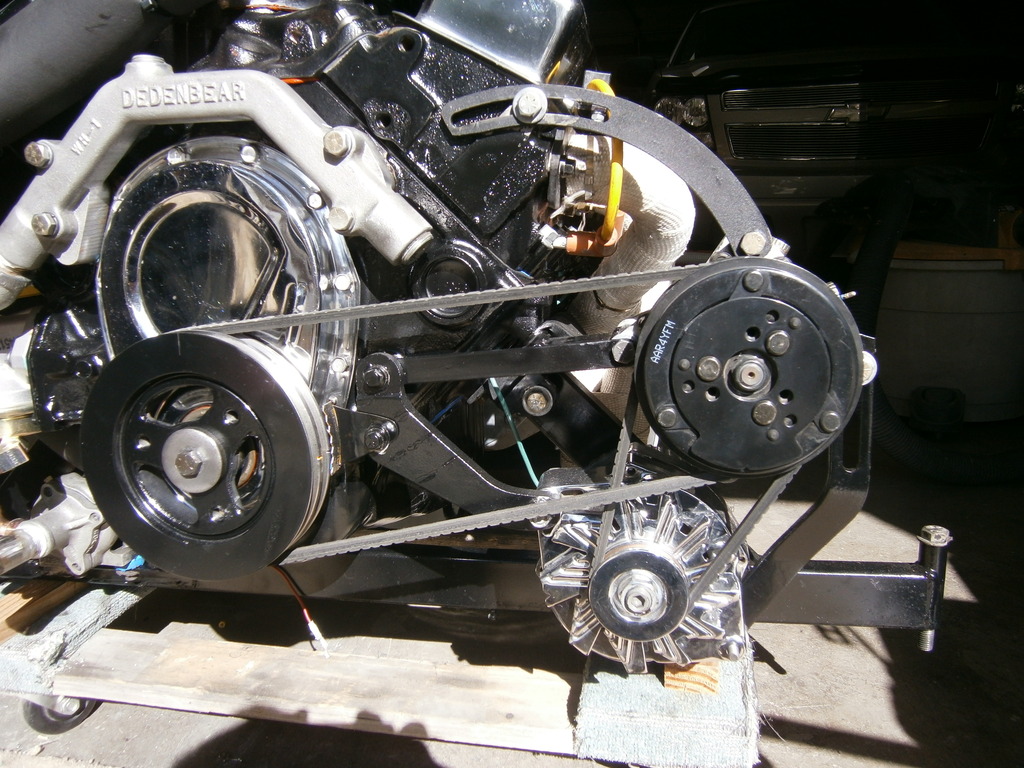
Posted by: BRAVE_HELIOS Apr 26 2017, 08:23 AM
Just a couple of things.
Electric pumps flow less coolant than a mechanical water pump at nearly everything above idle, if you're having a cooling issue installing an electric pump is going backwards. The reasons to install an electric pump are if you need to remotely mount a water pump or you're trying to get the absolute most horsepower you can out of an engine. If you think the water pump is the issue, get a Stewart high flow water pump and be done with it knowing you've got the best on there and it's not a WP issue.
More flow=more cooling, it's physics. You don't want to slow down your flow, a restriction will only cause problems, not help them.
If you're having problems, I'd first make sure what I had is working correctly. It sounds like you're having issues, or at least worried about bleeding the system. When I was building my V8 Volvo, I had similar issues which took out a headgasket before I bought an Airview coolant refill kit, and eventually ditched my convoluted setup. It uses shop air to create a vacuum and then sucks the coolant back in leaving it perfectly filled without air voids. Looks like there are cheaper ones out there like https://www.ecstuning.com/b-schwaben-parts/coolant-refill-air-purge-tool/003466sch01/. Yeah, it's a bit of money, but it's worth it -- it makes my life so much easier on dozens of cars (but not my bugs or 914).
I don't know the history of your engine, but if you're sure that you don't have any mechanical issues (such as head gasket, or timing) that could cause it to run hot, I'd reconsider the size of my radiator and the airflow through it.
I looked at the Airview system:
https://www.ecstuning.com/b-schwaben-parts/coolant-refill-air-purge-tool/003466sch01/
Wouldn't my vacuum brake bleed tool work the same? When connected; it uses vacuum from a compressor to draw out coolant from the radiator petcock and as long as I keep the overflow bottle full; I can continue bleeding the system like this until (I feel?) the system has been successfully bled.
Posted by: BRAVE_HELIOS Apr 26 2017, 08:55 AM
Here's the timing mark setup on my engine. The orange mark on the balancer is at TDC and 0 degrees on the timing pointer. It would be nice to have it lower but I can still easily see it from under the car.

Awesome! But it looks like the engine has to come out in order for me to do this... that's a lot of work :-)!
Posted by: 914GT Apr 26 2017, 10:06 AM
Right, one of those things that would be done with the engine out. If you need to drop the engine to take care of other issues then adding a relocated timing mark would be something to add to the list.
Posted by: burton73 Apr 26 2017, 11:45 AM
Just wondering. The picture of your SBC with a Dedenbear WH-1 got me curious.
I went to their site and saw that they had Electric water pumps set to flow 23 GPM.
The other pumps that where covered in posting pumped much more that that. Question is a slower GPM flow better for cooling. I think it has been posted many years ago but I cannot remember. Also where do you get a Vibration Dampener for a HP SBC with a V belt grove? I have a very old one from GM in the 60s.
Bob B
Posted by: 914GT Apr 26 2017, 01:00 PM
The Dedenbear remote pump on my conversion has performed very well for the past 15 years so I don't feel that GPM numbers are extremely critical. Obviously you need enough coolant flow to prevent excessive coolant temperatures where it exits the engine and hot spots inside the engine. But that's also going to be dependent on the engine inlet temperature (and radiator performance). The more important factors are going to be radiator size and efficiency, and controlled air flow through the radiator. The pump is moving the heat from the engine to the radiator, the actual heat exchange is from the radiator to the air. That is where more flow is better (air flow) and not really the coolant flow rate from engine to radiator. There are a lot of arguments over this, not just in the 914 conversion world, and that's fine. But I know the setup I have works well for me.
Another thing that needs to be considered is that even though a pump can flow a maximum GPM under ideal or no-load conditions it won't necessarily be able to flow that rate in an real closed cooling system. The engine block, heads, thermostat, pipes/hoses and radiator will all restrict flow and trying to force a higher GPM through the system can result in excessive pressures or turbulence. It would be nice to know if there's an optimum GPM for a system but that's probably unique for every situation. If you had a flow meter with temperature & pressure gauges you could probably get some numbers to take some of the mystery out of this.
On the V-groove balancer that is a GM part, p/n 3896590. As far as I know it's still available from GM and other sources online.
Posted by: dwillouby Apr 27 2017, 06:33 AM
Glad I saw this! I am going to order this pump as I currently have the Renagade setup.
Mine seems to cool fine but the engine heat soaks when shut down. I want the use the electric pump to run after the engine stops and circulate till temps come down.
I was going to try the Davies Craig pump but have to rework things. I will sell this pump(new in box) to buy the other.
David
Posted by: BIGKAT_83 Apr 27 2017, 06:46 AM
Glad I saw this! I am going to order this pump as I currently have the Renagade setup.
Mine seems to cool fine but the engine heat soaks when shut down. I want the use the electric pump to run after the engine stops and circulate till temps come down.
I was going to try the Davies Craig pump but have to rework things. I will sell this pump(new in box) to buy the other.
David
This will answer a few questions about which cools better belt driven or electric. Interested to see if you see any difference in the cooling when running. I'm thinking of going with a electric pump just to free up space to mount a ac compressor.
Bob
Posted by: burton73 Apr 27 2017, 10:50 AM
Thanks for the lead on Davies Craig pump I looked them up on the web.
It sure looks trick. Davies Craig DC-8870
The EWP 130 is made of aluminum with AN fittings. Not sure what model would work best for SBC and 914 layouts but I guess this is it. $465. For the kit with controller. Another $114. For the SBC set up on the engine. Davies Craig DC-0444 - Davies Craig Digital Thermatic Fan Switch Kits . $77. More
Not sure if that is it but the full boat is looks like it would be like it is $656. Not cheap but if it works perfect?
Bob B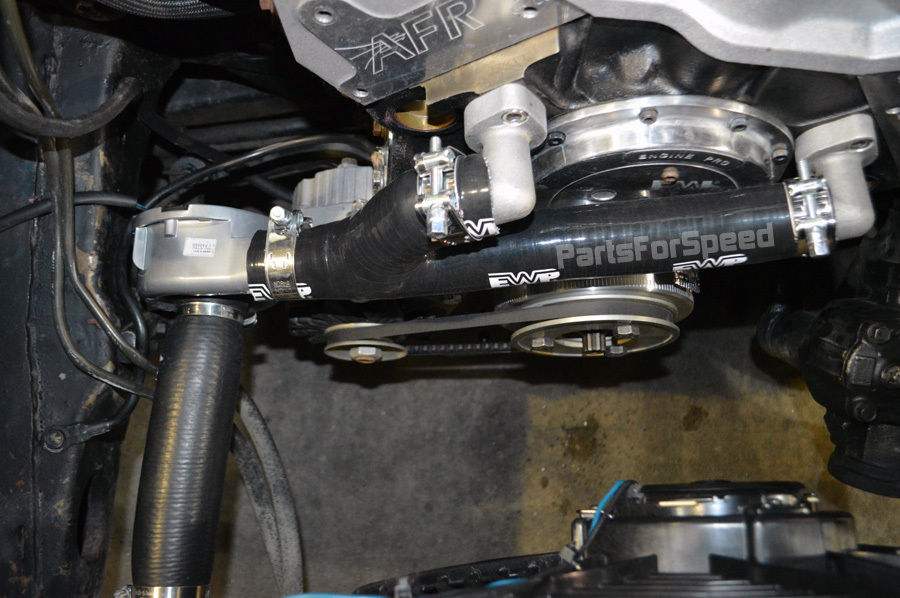
Posted by: dwillouby Apr 28 2017, 01:25 PM
Ordered the Jegs pump today.
Will see what happens.
To help with the new pump I will sell the Davies Craig pump and parts I have.
New never ran.
200.00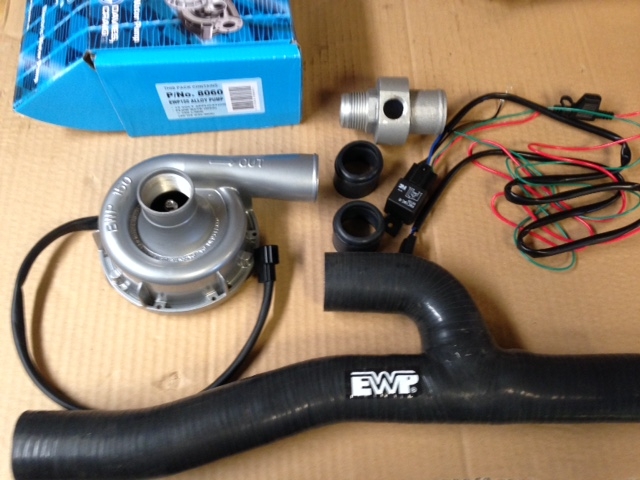
Posted by: Andyrew Apr 28 2017, 01:50 PM
I highly recommend the LCD controller for the davies craig pump. I LOVE mine.
The water pump runs on its pulse setting pretty much the entire time because its so efficient. It actually rarely gets up to temp doing that. Which I guess I should have guessed since I bought the v8 pump for my 1.8T..
Posted by: BRAVE_HELIOS Apr 28 2017, 02:07 PM
Ordered the Jegs pump today.
Will see what happens.
To help with the new pump I will sell the Davies Craig pump and parts I have.
New never ran.
200.00

So why are you going from this pump to the Jegs unit? Depending on what you say... I may be interested in your Davies pump!
Posted by: dwillouby Apr 28 2017, 02:21 PM
Basically It will be less reworking of my system and cost.
I already have the Renagade pump and the hoses connected.
With the Davies pump I will need to change the hose arrangement and add a Dedenbear water log, fittings ect.
I may regret selling the davies system but who knows?
David
Posted by: BRAVE_HELIOS Apr 28 2017, 02:29 PM
Basically It will be less reworking of my system and cost.
I already have the Renagade pump and the hoses connected.
With the Davies pump I will need to change the hose arrangement and add a Dedenbear water log, fittings ect.
I may regret selling the davies system but who knows?
David
I understand... I would be in the same situation. Well, let me know how it goes with the Jegs unit because I might very well be the next test case for the same!
Posted by: BRAVE_HELIOS May 3 2017, 08:26 PM
An update... Today, I had a chance to drive the car after removing the Prestone flushing fluid and bleeding the system the best I could. I drove for around 3 miles before the temp crept up past 200. This is with the temp controller set for the fan to come on at 180. Ambient air temp was around 72 degrees and I got it up to 70 as a short burst and around 50 most of the rest of the way. This trek was actually better than before where 3 miles would have been a miracle. Was it all the flushing? I have read that a good flushing takes a long time and with many attempts. IDK but obviously, this is still not enough.
When I did get it home, the temp was around 200. I shut it down and opened the trunk where I noticed the overflow tank was full and in a matter of a few moments, water started coming out of the overflow hose of the tank and onto the ground. Mind you when I started the trip, the overflow tank had water in it (that was post bleeding and idling in the garage for a long period of time). I went back to the car after 20 minutes or so and the system had sucked ALL the water from the overflow tank back in... and probably sucked in air at that point too.
I did notice something though... now the car can sit idling in the garage for an hour or longer and never go past 180. It's not until I take it for a drive will the temperature increase.
Did I not read somewhere that when this occurs, it is relatively clear that it is more a function of a defect in air flow through the rad and/or how the hot air expels from the front trunk area and not from deficient water pump flow?
I am trying to come up with the next logical part of the system to address.
Posted by: BRAVE_HELIOS May 4 2017, 11:10 AM
Any one have insight to the running hot when driving versus at idle issue... please :-) .
Posted by: 914GT May 4 2017, 11:43 AM
If you're spilling out that much coolant it would seem to me that your system isn't holding pressure. Did you check by pressuring the system (cold) using compressed air and a gauge to see what point your radiator cap opens?
When you're driving the engine is under load and is going to generate more heat. So holding correct pressure (15-17 psi static) is going to be an important factor. Possibly there is some kind of turbulence in the radiator air flow while in motion. I suppose you could see what difference it makes driving around with your hood off as an experiment. I kind of doubt this is the problem though. My guess there's still a pressure problem or maybe still trapped air in the radiator or above the intake manifold somewhere.
Posted by: BRAVE_HELIOS May 4 2017, 12:26 PM
If you're spilling out that much coolant it would seem to me that your system isn't holding pressure. Did you check by pressuring the system (cold) using compressed air and a gauge to see what point your radiator cap opens?
When you're driving the engine is under load and is going to generate more heat. So holding correct pressure (15-17 psi static) is going to be an important factor. Possibly there is some kind of turbulence in the radiator air flow while in motion. I suppose you could see what difference it makes driving around with your hood off as an experiment. I kind of doubt this is the problem though. My guess there's still a pressure problem or maybe still trapped air in the radiator or above the intake manifold somewhere.
You know; the expansion (header) tank is from a VW Passat I got from the breakers yard. It looked in good nick but just in case, I replaced the cap with a new one. Perhaps the tank really is hosed. Any recommendation on the type of tank I should look for?
Posted by: 914GT May 4 2017, 01:37 PM
The most common is probably one similar to this. The small fitting fits a hose going to your overflow tank.
Renegade makes one that looks nice. This would have to connect into your system with a tee and be mounted high in the engine bay.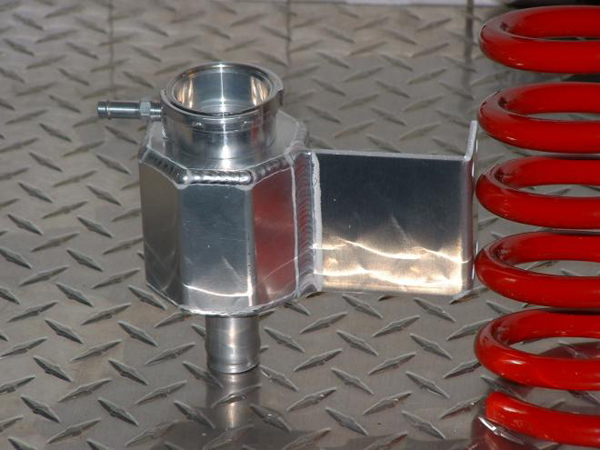
I use a modified Dedenbear tank that bolts onto the intake manifold over the thermostat. It has a lot of volume but it can be a little awkward to fill. I just use a long funnel and it's something I only need to do every few years.
Are you sure the cap on your Passat tank is a pressure cap and not simply a fill cap? Is there a pressure rating on it? Having never seen one I don't know anything about that.
Edit: Here's a used Dedenbear tank with an AN fitting. This one is on ebay for $75. These tanks have a section of clear nylon tubing so you can visually check the coolant level in the system. Mine had that but the tubing discolored after a few years and I plugged the holes. To clear the firewall on mine I cut off the hose connection and tapped the hole to thread in a 90 deg fitting.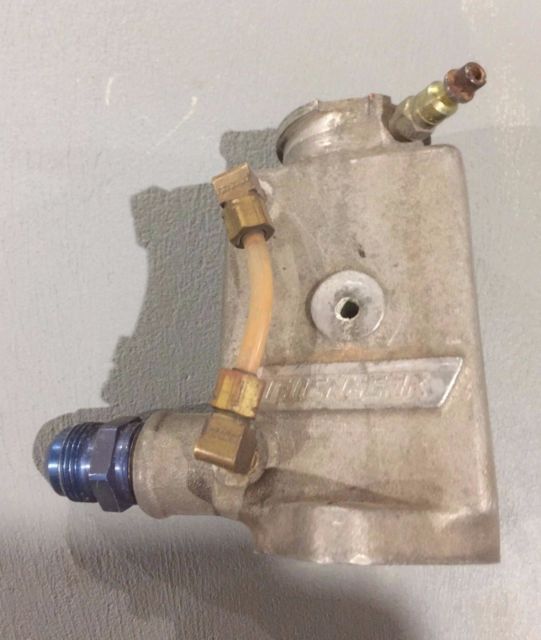
Posted by: burton73 May 4 2017, 01:59 PM
The most common is probably one similar to this. The small fitting fits a hose going to your overflow tank.

Renegade makes one that looks nice. This would have to connect into your system with a tee and be mounted high in the engine bay.

I use a modified Dedenbear tank that bolts onto the intake manifold over the thermostat. It has a lot of volume but it can be a little awkward to fill. I just use a long funnel and it's something I only need to do every few years.
Are you sure the cap on your Passat tank is a pressure cap and not simply a fill cap? Is there a pressure rating on it? Having never seen one I don't know anything about that.
Edit: Here's a used Dedenbear tank with an AN fitting. This one is on ebay for $75. These tanks have a section of clear nylon tubing so you can visually check the coolant level in the system. Mine had that but the tubing discolored after a few years and I plugged the holes. To clear the firewall on mine I cut off the hose connection and tapped the hole to thread in a 90 deg fitting.

Why would there be a quick connect air fitting on the Dedenbear tank overflow tube? Good-looking parts.
Bob B
Posted by: 914GT May 4 2017, 02:05 PM
That I don't know. The listing says it came off a rear-engine dragster. Maybe they pressurized their system with an air hose for leak testing? I wouldn't think they'd bother with an overflow tank on a dragster.
Posted by: Andyrew May 4 2017, 03:44 PM
If you're spilling out that much coolant it would seem to me that your system isn't holding pressure. Did you check by pressuring the system (cold) using compressed air and a gauge to see what point your radiator cap opens?
When you're driving the engine is under load and is going to generate more heat. So holding correct pressure (15-17 psi static) is going to be an important factor. Possibly there is some kind of turbulence in the radiator air flow while in motion. I suppose you could see what difference it makes driving around with your hood off as an experiment. I kind of doubt this is the problem though. My guess there's still a pressure problem or maybe still trapped air in the radiator or above the intake manifold somewhere.
You know; the expansion (header) tank is from a VW Passat I got from the breakers yard. It looked in good nick but just in case, I replaced the cap with a new one. Perhaps the tank really is hosed. Any recommendation on the type of tank I should look for?
Just get a new passat expansion tank and try it out. They are only ~$20
Posted by: BRAVE_HELIOS May 4 2017, 07:34 PM
The most common is probably one similar to this. The small fitting fits a hose going to your overflow tank.

Renegade makes one that looks nice. This would have to connect into your system with a tee and be mounted high in the engine bay.

I use a modified Dedenbear tank that bolts onto the intake manifold over the thermostat. It has a lot of volume but it can be a little awkward to fill. I just use a long funnel and it's something I only need to do every few years.
Are you sure the cap on your Passat tank is a pressure cap and not simply a fill cap? Is there a pressure rating on it? Having never seen one I don't know anything about that.
Edit: Here's a used Dedenbear tank with an AN fitting. This one is on ebay for $75. These tanks have a section of clear nylon tubing so you can visually check the coolant level in the system. Mine had that but the tubing discolored after a few years and I plugged the holes. To clear the firewall on mine I cut off the hose connection and tapped the hole to thread in a 90 deg fitting.

My original set up included something very much like the Moroso unit you show (first/top picture). I was told that was not a good way to go so I removed that piece and adapted the VW expansion tank setup. In the picture below, that Moroso piece would have been mounted where the high pressure 'T' from the T-stat to the expansion tank is now located.
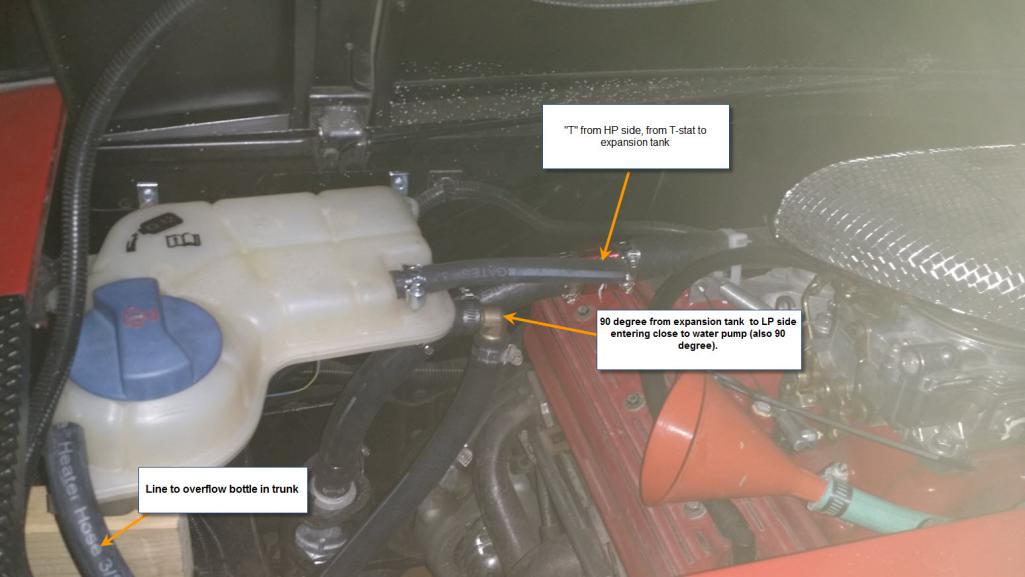
Posted by: BRAVE_HELIOS May 4 2017, 08:48 PM
Someone needs to explain this to me. The tanks in the pictures have two ports (excluding the filler neck where the pressure cap attaches). The VW expansion tank I have has three ports... one from HP side (from T stat), one to LP side before entering water pump and one from expansion tank to overflow (reservoir). How do the two port tanks connect?
Posted by: 914GT May 4 2017, 09:57 PM
On what you call a two-port expansion tank, one side of it is pressurized and connected into the cooling system. The other port is after the pressure cap so that as the coolant expands it goes past the cap and into the non-pressurized overflow tank. These tanks typically connect high in the system and above the thermostat in the intake manifold. This allows any air to get purged out into the overflow tank, then as the engine cools down only coolant is allowed back into the system. So air is automatically purged out during heating and cooling cycles.
I've wondered how the Passat tank is designed. If it connects to both the suction side of the water pump and after the thermostat (hose going to radiator) then what prevents coolant from bypassing the radiator and flowing through the tank? Is this how it is connected in a Passat? Is there something inside the tank that prevents bypassing the radiator?
Posted by: Andyrew May 4 2017, 09:58 PM
2 port tanks dont constantly purge the trapped air. They simply have a line that holds water, and then another line for overflow. Thats why the 3 port VW tank is optimal and what you see in every modern vehicle.
Posted by: BRAVE_HELIOS May 4 2017, 10:12 PM
2 port tanks dont constantly purge the trapped air. They simply have a line that holds water, and then another line for overflow. Thats why the 3 port VW tank is optimal and what you see in every modern vehicle.
Well, that's good news. Can you tell me if you believe mine is connected correctly by looking at the pictures? I will try to find a new 3 port tank that takes a standard pressure cap.
Posted by: 914GT May 5 2017, 07:45 AM
I don't know anything about the Passat tank and how it's attached in a factory system. Hopefully there are others on the board who has used it and can advise you about that.
Posted by: BRAVE_HELIOS May 5 2017, 08:16 AM
I don't know anything about the Passat tank and how it's attached in a factory system. Hopefully there are others on the board who has used it and can advise you about that.
I did it like this... follow the flow!
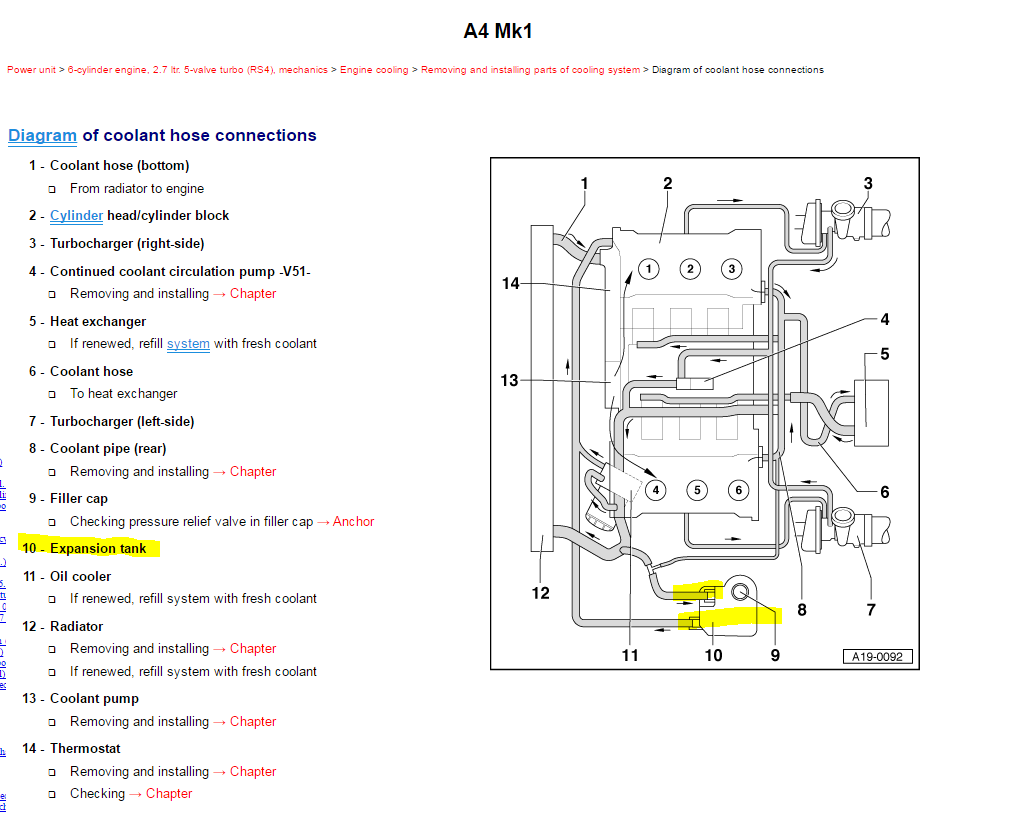
Posted by: 914GT May 5 2017, 08:40 AM
It looks like it is essentially in parallel with the radiator. The unknown is how much coolant is bypassed through the tank. Obviously it has been designed to work in the Passat 6-cylinder application but is this good in a 914 Chevy V8 conversion where you need as much cooling capacity as possible? I'm not saying this won't work, and maybe it's been used in other 914 conversions successfully. What I am saying is this tank is a different setup then the usual small block Chevy cooling system. To me it would be unnecessary to have the line going back to the suction side of the pump. Maybe you could clamp this line off and see how it affects the cooling?
Posted by: Andyrew May 5 2017, 08:51 AM
2 port tanks dont constantly purge the trapped air. They simply have a line that holds water, and then another line for overflow. Thats why the 3 port VW tank is optimal and what you see in every modern vehicle.
Well, that's good news. Can you tell me if you believe mine is connected correctly by looking at the pictures? I will try to find a new 3 port tank that takes a standard pressure cap.
Yes it does look correct. The small line is the high HOT side. Should be the highest line in your system.
The big lower line is the return to cold side. Feeding into the water pump works perfect.
Posted by: Andyrew May 5 2017, 08:55 AM
To me it would be unnecessary to have the line going back to the suction side of the pump. Maybe you could clamp this line off and see how it affects the cooling?
Thats the whole purpose of this expansion tank. Its constantly purging the coolant. Air bubbles and coolant flow into the tank from the small line, then coolant only returns back into the system.
Posted by: 914GT May 5 2017, 09:17 AM
That sound's like a good design especially when the cooling system is together in the same engine compartment. It may not be quite as effective when the radiator is separated from the engine by lines that are low in the cooling system. Also a small V6 is going to have lower cooling demands then a larger displacement V8. I would have to disagree about the 2-port tank not able to purge air. It does this quite effectively as long as it's the highest point in the system, but as with any of them there needs to be a petcock or other arrangement to eliminate trapped air in the radiator on a 914 conversion. Again I'm not saying the Passat tank will not work, or maybe has some advantages over the other tanks, but it's a variation on what is commonly used and it may be having something to do with the overheating problem.
Posted by: BRAVE_HELIOS May 5 2017, 10:42 AM
That sound's like a good design especially when the cooling system is together in the same engine compartment. It may not be quite as effective when the radiator is separated from the engine by lines that are low in the cooling system. Also a small V6 is going to have lower cooling demands then a larger displacement V8. I would have to disagree about the 2-port tank not able to purge air. It does this quite effectively as long as it's the highest point in the system, but as with any of them there needs to be a petcock or other arrangement to eliminate trapped air in the radiator on a 914 conversion. Again I'm not saying the Passat tank will not work, or maybe has some advantages over the other tanks, but it's a variation on what is commonly used and it may be having something to do with the overheating problem.
With the system I have now, the highest point is where coolant from the high pressure side (just downstream of T-stat) enters the expansion tank. This point (port) sits higher than the T-stat and higher than the top of the radiator. The only part of the system that might sit higher is the heater core. If this is indeed the case; what can I do to ensure the flow and the bleed process works correctly?
Posted by: Andyrew May 5 2017, 10:52 AM
That sound's like a good design especially when the cooling system is together in the same engine compartment. It may not be quite as effective when the radiator is separated from the engine by lines that are low in the cooling system. Also a small V6 is going to have lower cooling demands then a larger displacement V8. I would have to disagree about the 2-port tank not able to purge air. It does this quite effectively as long as it's the highest point in the system, but as with any of them there needs to be a petcock or other arrangement to eliminate trapped air in the radiator on a 914 conversion. Again I'm not saying the Passat tank will not work, or maybe has some advantages over the other tanks, but it's a variation on what is commonly used and it may be having something to do with the overheating problem.
With the system I have now, the highest point is where coolant from the high pressure side (just downstream of T-stat) enters the expansion tank. This point (port) sits higher than the T-stat and higher than the top of the radiator. The only part of the system that might sit higher is the heater core. If this is indeed the case; what can I do to ensure the flow and the bleed process works correctly?
You need to add some kind of T at your highest point in your engine bay and make that your new expansion tank high line.
For the front end what I do is run a line off the radiator high point with about a foot of hose and hold it straight up. Once that line is pushing pure water I know the radiator is good.
Same for your heater. You need to make a "T" for your heater at the high point, that way you can do the same there. Cap it off when its full.
The system should work the air bubbles out of it naturally with a modern 3 hose expansion, but it could take some time. Thats why I force it out at the beginning. Makes things easy.
Posted by: BRAVE_HELIOS May 5 2017, 11:17 AM
That sound's like a good design especially when the cooling system is together in the same engine compartment. It may not be quite as effective when the radiator is separated from the engine by lines that are low in the cooling system. Also a small V6 is going to have lower cooling demands then a larger displacement V8. I would have to disagree about the 2-port tank not able to purge air. It does this quite effectively as long as it's the highest point in the system, but as with any of them there needs to be a petcock or other arrangement to eliminate trapped air in the radiator on a 914 conversion. Again I'm not saying the Passat tank will not work, or maybe has some advantages over the other tanks, but it's a variation on what is commonly used and it may be having something to do with the overheating problem.
With the system I have now, the highest point is where coolant from the high pressure side (just downstream of T-stat) enters the expansion tank. This point (port) sits higher than the T-stat and higher than the top of the radiator. The only part of the system that might sit higher is the heater core. If this is indeed the case; what can I do to ensure the flow and the bleed process works correctly?
In the engine bay; There is a T in already in place… that is where the coolant enters the expansion tank. The expansion tank itself is sitting pretty much at the highest point in the engine bay (millimeters from hitting the engine cover).
I like your idea of the hose for the radiator. I can attach a hose on the rad petcock and do the same?
I have a flushing T just inches before the hose enters the heater core and sitting at about the same level. I can use that there too.
Posted by: BRAVE_HELIOS May 5 2017, 11:25 AM
Was reading a Chevy forum about running hot issues but only when driving (at speed) and someone mentioned that perhaps the pump is spinning in the wrong direction? As in; the incorrect pump was purchased for the application?
My remote pump is mounted on the left side… opposite of what the Renegade manual shows to do. But it seems to me that it should not matter which side the pump is mounted as the rotation of the pump will be the same.
Is this correct? What about might there be different BB Chrysler pumps for different rotations? How would I test this?
This info came from here:
http://www.chevytalk.org/fusionbb/showtopic.php?tid/58316/
Posted by: BRAVE_HELIOS May 5 2017, 03:21 PM
More reading about this. Other than going with an electric H2O pump; I feel I have exhausted most of my options. I mean this thing should be running as cold as ice right now!
I have a good quality, 2 row aluminum radiator.
I have a very strong fan.
The grill air passage to the rad is so tight, it can keep a license plate sucked right up to the grill.
The expansion tank might be bad and I will replace it.
The whole cooling system has been cleaned out with ThermoCure and citric acid (Prestone) with great care taken not to get radiator clogged.
Now there is the elephant in the room… failed cylinder head gaskets or heads. When I made the swap, I only pulled the bottom of the engine apart and left the top end alone (PO said engine ran strong). What would be the tell-tail signs if the heads were causing the overheat issue? How can I test for this? From what I can see; there is no discernable amounts of oil in the coolant nor coolant in the oil.
Sigh ![]() … can I remove the heads while the engine is still in the car?
… can I remove the heads while the engine is still in the car?
Posted by: Andyrew May 5 2017, 03:27 PM
More reading about this. Other than going with an electric H2O pump; I feel I have exhausted most of my options. I mean this thing should be running as cold as ice right now!
I have a good quality, 2 row aluminum radiator.
I have a very strong fan.
The grill air passage to the rad is so tight, it can keep a license plate sucked right up to the grill.
The expansion tank might be bad and I will replace it.
The whole cooling system has been cleaned out with ThermoCure and citric acid (Prestone) with great care taken not to get radiator clogged.
Now there is the elephant in the room… failed cylinder head gaskets or heads. When I made the swap, I only pulled the bottom of the engine apart and left the top end alone (PO said engine ran strong). What would be the tell-tail signs if the heads were causing the overheat issue? How can I test for this? From what I can see; there is no discernable amounts of oil in the coolant nor coolant in the oil.
Sigh
Probably cant remove the head, its a little tight. You could probably drop the trans and get a little better clearance if you took your dizzy out.
I would leakdown test your engine. If you dont have coolant in the oil and vice versa the only place for the coolant to go apart from external is through the exhaust. Is your exhaust tips white/clean? Pull your plugs and take a borescope to the pistons, are any of them really clean? If so leakdown test is definitely in order.
Posted by: Andyrew May 5 2017, 03:31 PM
Have you pressure tested your system yet?
Posted by: BRAVE_HELIOS May 5 2017, 03:33 PM
Have you pressure tested your system yet?
I have yet to perform a compression test oor leak down test.
Posted by: 3liter914-6 May 6 2017, 09:55 PM
I have yet to perform a compression test oor leak down test.
He's saying pressure test the cooling system, it's a pump that you can use to check to see if the system is holding pressure--they're fairly effective at identifying most leaks in a cooling system. The vacuum tool that I showed you can also be used the same way, if you vacuum the system and the vacuum doesn't hold in the green zone then you've got a leak somewhere--potentially headgasket. I have both though, as the pressure tester is a little better at pinpointing leaks, but both will indicate an issue that requires attention.
You can also perform a combustion gas check on the coolant to see if you've got a leak from the combustion chamber.
Running hot at speed can be a lot of things, insufficient airflow, clogged or poorly sized radiator, trapped air, low coolant/insufficient water flow, tuning issues, head gasket, etc.
I'll say again, you should make sure that what you have is working properly before you throw more parts at things, and part of that is making sure the system is properly bled. The vacuum tools are amazing, and make coolant filling so easy and trouble free
Posted by: burton73 May 6 2017, 11:00 PM
You where saying decent temps of 180-200. You then said creeping up past 200.
Does it stop there or did you just stop. My V8 914 in 78 went to 200 a lot. I also owned a 85 corvette in 94 that the heat went past 220 and I just did not want to stop and I was in the desert and had 2 miles to go and I said screw it and overheated it and blew a head gasket. No water got in the Eng. One of my guys put a new head gasket in it and it was fine.
So how hot has your car got?
Bob B
Posted by: BRAVE_HELIOS May 7 2017, 09:57 PM
I have yet to perform a compression test oor leak down test.
He's saying pressure test the cooling system, it's a pump that you can use to check to see if the system is holding pressure--they're fairly effective at identifying most leaks in a cooling system. The vacuum tool that I showed you can also be used the same way, if you vacuum the system and the vacuum doesn't hold in the green zone then you've got a leak somewhere--potentially headgasket. I have both though, as the pressure tester is a little better at pinpointing leaks, but both will indicate an issue that requires attention.
You can also perform a combustion gas check on the coolant to see if you've got a leak from the combustion chamber.
Running hot at speed can be a lot of things, insufficient airflow, clogged or poorly sized radiator, trapped air, low coolant/insufficient water flow, tuning issues, head gasket, etc.
I'll say again, you should make sure that what you have is working properly before you throw more parts at things, and part of that is making sure the system is properly bled. The vacuum tools are amazing, and make coolant filling so easy and trouble free
I rented a cooling system pressure tester from O'Reily's a while back. The kit did not have the correct adapter for a VW expansion tank so I had to fabricate my own. My son had to hold it in place while I pressurized the system. I used it mostly to purge air from the radiator petcock and not to test holding pressure.
Today; I took a ride to my local breakers yard and specifically looked for an expansion tank that was from a V8 car and that had the standard twist/lock pressure cap. Found one out of a Crown Vic/Grand Marquis that fit the bill. Took it home and made a temporary mount to test it. Right away. I noticed that where previously with the VW expansion tank, coolant would eventually flow out of the expansion tank and into overflow tank then would begin to fill up the overflow tank until it overflowed to the ground. This did not occur with the Ford unit. The overflow tank level did not have any discernible change in coolant level. Good sign, I hope.
Although I could not find anyone around here that rents out leak down testers, I will go to the FLAPS and rent out the pressure tester again.
If I understand this tool correctly; it will show me external leaks fairly immediately and will let me know of internal leaks by whether the pressure drops over X amount of time. Is this the correct way to diagnose with the pressure tester?
Posted by: BRAVE_HELIOS May 7 2017, 10:06 PM
You where saying decent temps of 180-200. You then said creeping up past 200.
Does it stop there or did you just stop. My V8 914 in 78 went to 200 a lot. I also owned a 85 corvette in 94 that the heat went past 220 and I just did not want to stop and I was in the desert and had 2 miles to go and I said screw it and overheated it and blew a head gasket. No water got in the Eng. One of my guys put a new head gasket in it and it was fine.
So how hot has your car got?
Bob B
Hey Bob,
Quite the story with the Vette!
I do not think my car has ever overheated (with the engine in the 914 anyway... previous owner... possibly).
The gauge continues to read even after the engine is shut down. I have seen the temp creep up past 220 like this. I have also seen the coolant bubble (boil?) in the overflow tank once or twice... cannot recall what the temp was reading at the time but I am sure it was up there.
I am going to rent a pressure tester tomorrow and see what happens. I would like to rent a leak down tester but it seems that no one around here rents one!
Posted by: BRAVE_HELIOS May 8 2017, 08:10 PM
I have yet to perform a compression test oor leak down test.
He's saying pressure test the cooling system, it's a pump that you can use to check to see if the system is holding pressure--they're fairly effective at identifying most leaks in a cooling system. The vacuum tool that I showed you can also be used the same way, if you vacuum the system and the vacuum doesn't hold in the green zone then you've got a leak somewhere--potentially headgasket. I have both though, as the pressure tester is a little better at pinpointing leaks, but both will indicate an issue that requires attention.
You can also perform a combustion gas check on the coolant to see if you've got a leak from the combustion chamber.
Running hot at speed can be a lot of things, insufficient airflow, clogged or poorly sized radiator, trapped air, low coolant/insufficient water flow, tuning issues, head gasket, etc.
I'll say again, you should make sure that what you have is working properly before you throw more parts at things, and part of that is making sure the system is properly bled. The vacuum tools are amazing, and make coolant filling so easy and trouble free
I rented a cooling system pressure tester from O'Reily's a while back. The kit did not have the correct adapter for a VW expansion tank so I had to fabricate my own. My son had to hold it in place while I pressurized the system. I used it mostly to purge air from the radiator petcock and not to test holding pressure.
Today; I took a ride to my local breakers yard and specifically looked for an expansion tank that was from a V8 car and that had the standard twist/lock pressure cap. Found one out of a Crown Vic/Grand Marquis that fit the bill. Took it home and made a temporary mount to test it. Right away. I noticed that where previously with the VW expansion tank, coolant would eventually flow out of the expansion tank and into overflow tank then would begin to fill up the overflow tank until it overflowed to the ground. This did not occur with the Ford unit. The overflow tank level did not have any discernible change in coolant level. Good sign, I hope.
Although I could not find anyone around here that rents out leak down testers, I will go to the FLAPS and rent out the pressure tester again.
If I understand this tool correctly; it will show me external leaks fairly immediately and will let me know of internal leaks by whether the pressure drops over X amount of time. Is this the correct way to diagnose with the pressure tester?
Update... I went and rented a pressure tester. When I got home, I removed the cap from the Crown Vic expansion tank and immediately noticed that the expansion was still full of coolant. I had never experienced that with the Passat expansion tank... that tank was always half empty... no matter how many times I filled it before driving... always.
I tested the 16 PSI cap and it checked out. Next, I pressurized the system to 16 PSI and even though it dropped a hair, it has been holding in the 15-16 PSI range on the gauge for over 10 minutes now. No external leaks and hopefully no internal leaks either. Good signs I think!
I read another test I can perform with the pressure tester is to remove all the spark plugs, pressurize the cooling system, then crank the engine to see if any coolant comes out of the spark plug holes.
Another is the exhaust gas tester for cooling systems.
It seems no one around here rents leak down tester or exhaust gas testers... it would suck to have to buy these things for one time testing.
Are the observations, tests and subsequent results performed so far enough to come to the determination that all is well with my cylinders and gaskets? I reckon it would be easy enough to perform the other test I mentioned with the pressure tester and removing the spark plugs... if I have to.
BTW... thanks for all your help!
Posted by: BRAVE_HELIOS May 9 2017, 06:32 PM
More good news... I rented a block tester/combustion leak tester; followed the directions and pumped for more than 2 minutes (instructions say 2 minutes) and the test fluid did not turn yellow... no combustion gasses in the coolant! What a relief! I will try it one more time before I return the kit. The photos shown are after I had pumped for over 2 minutes.
Now I can proceed!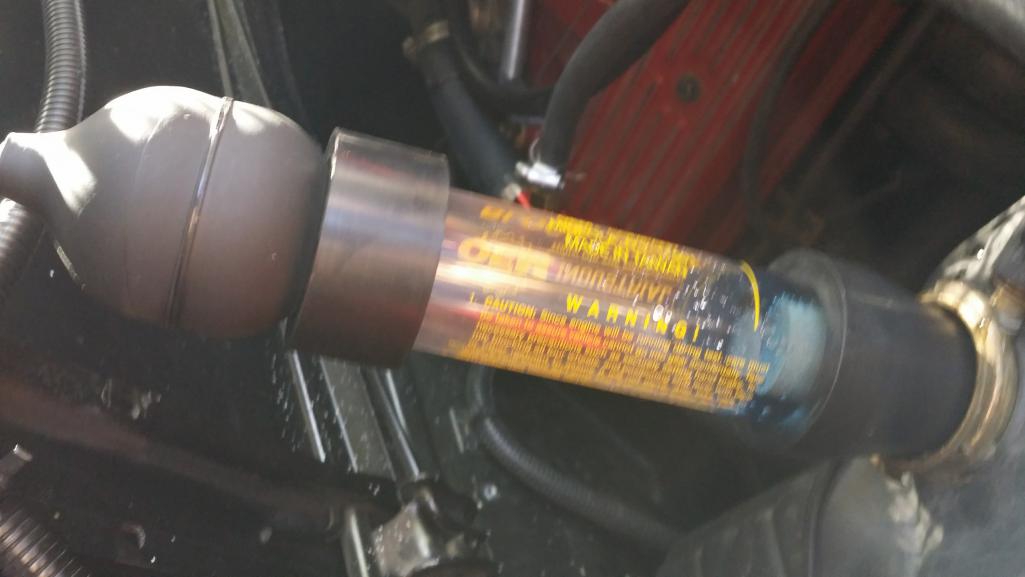
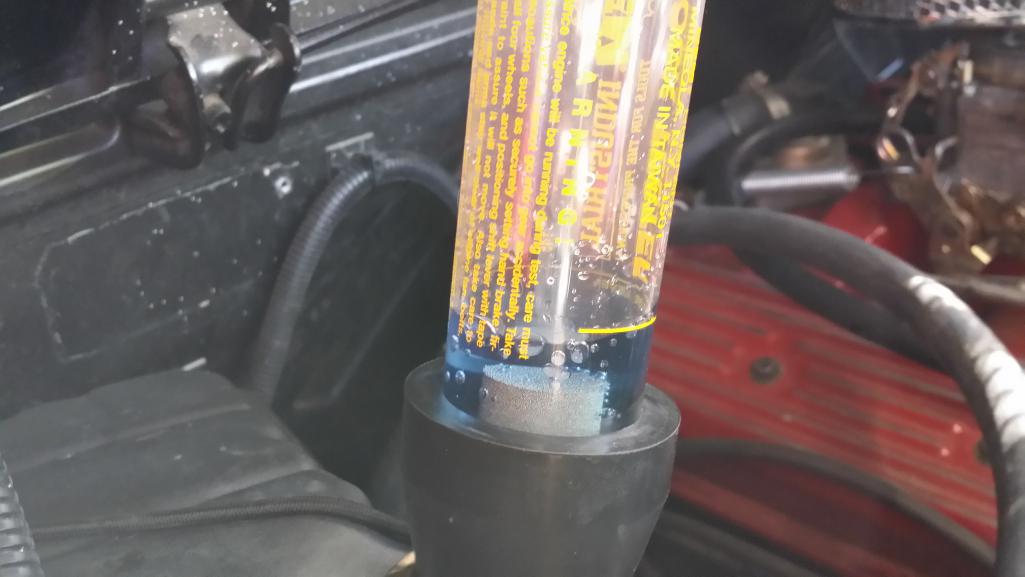
Posted by: Chris914n6 May 11 2017, 01:36 AM
The gauge continues to read even after the engine is shut down. I have seen the temp creep up past 220 like this. I have also seen the coolant bubble (boil?) in the overflow tank once or twice... cannot recall what the temp was reading at the time but I am sure it was up there.
Temp creep isn't uncommon, as the heat rises up to the temp sender. Coolant bubbling is common when there is air still trapped in the system.
Update... I went and rented a pressure tester. When I got home, I removed the cap from the Crown Vic expansion tank and immediately noticed that the expansion was still full of coolant. I had never experienced that with the Passat expansion tank... that tank was always half empty... no matter how many times I filled it before driving... always.
This doesn't surprise me. My engine in it's original car has a 9 quart cooling system. In my 914 it's 12 with the 20ft of 1 1/4" hose. Since the Passat tank was designed for a little 2.0 or 3.0 engine with 1-2ft hoses it's likely expanding beyond capacity.
Posted by: BRAVE_HELIOS May 11 2017, 08:39 AM
The gauge continues to read even after the engine is shut down. I have seen the temp creep up past 220 like this. I have also seen the coolant bubble (boil?) in the overflow tank once or twice... cannot recall what the temp was reading at the time but I am sure it was up there.
Temp creep isn't uncommon, as the heat rises up to the temp sender. Coolant bubbling is common when there is air still trapped in the system.
Update... I went and rented a pressure tester. When I got home, I removed the cap from the Crown Vic expansion tank and immediately noticed that the expansion was still full of coolant. I had never experienced that with the Passat expansion tank... that tank was always half empty... no matter how many times I filled it before driving... always.
This doesn't surprise me. My engine in it's original car has a 9 quart cooling system. In my 914 it's 12 with the 20ft of 1 1/4" hose. Since the Passat tank was designed for a little 2.0 or 3.0 engine with 1-2ft hoses it's likely expanding beyond capacity.
I can completely understand this if it weren't for the examples of other 914 V8 owners that seem to do all right with a small expansion tank... at least I think they are expansion tanks... little tanks with pressure caps attached.
I now need to make a permanent mount for the tank and take it out for a drive. Reckon I should also remove the restriction washer inserted in the radiator inlet too.
Posted by: Chris914n6 May 11 2017, 02:23 PM
You talking about this? It's a filler / air catcher (swirl can). Connects to the overflow bottle. Mine is on the output side of the engine. 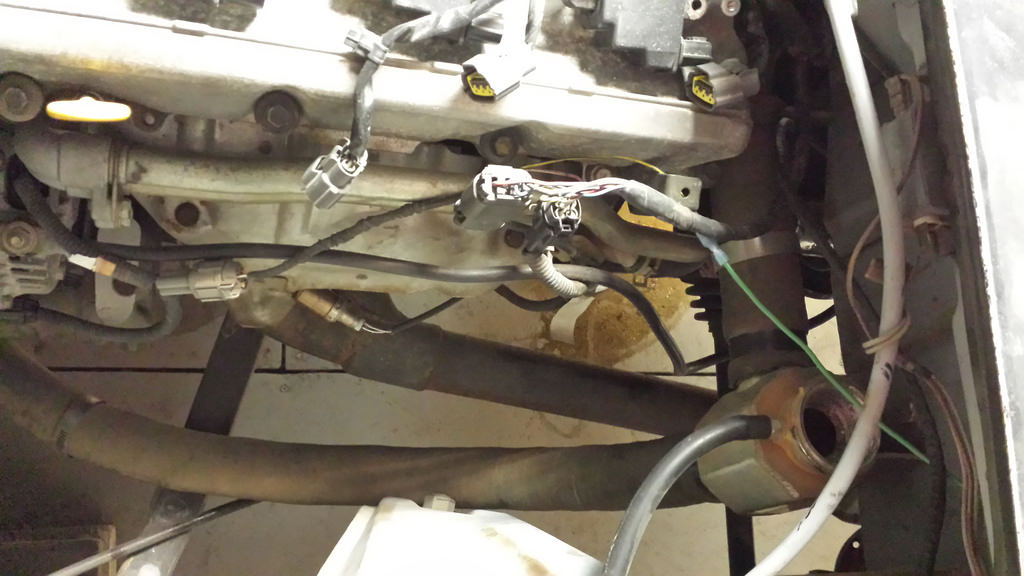
Replaced it with this when I replaced hoses & radiator.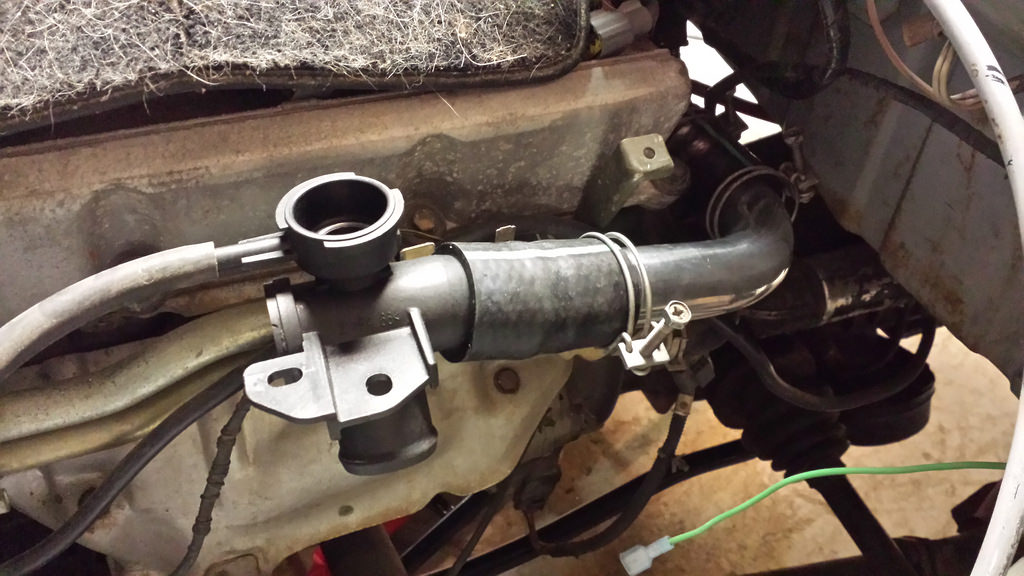
Posted by: dwillouby May 22 2017, 09:08 AM
Finally getting to work on the car. Work travel is killing me.
Have to machine the Renegade pump housing to allow the Jegs unit to fit.
The step on the jegs pump is a little over .500. I machined the housing .600 and enlarged the dia about.030.
Made a mounting bracket and in process of wiring the relays. Will have it come on with Ign. and also tied to the fan switch on the radiator to run after engine is off untill temp comes down.
test running the pump pushes a lot of air out of the system and should help bleeding ?
David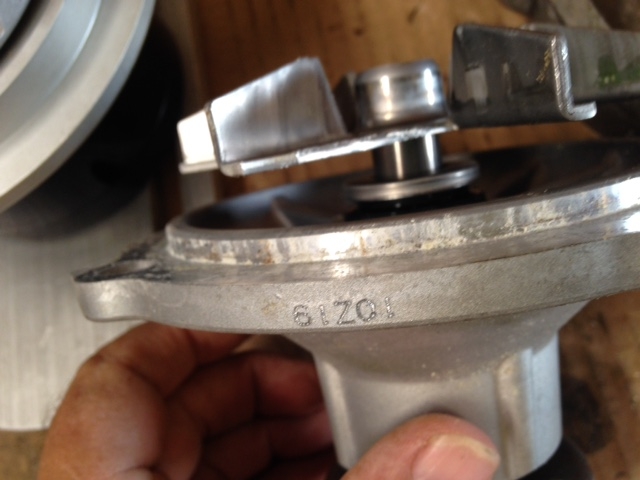
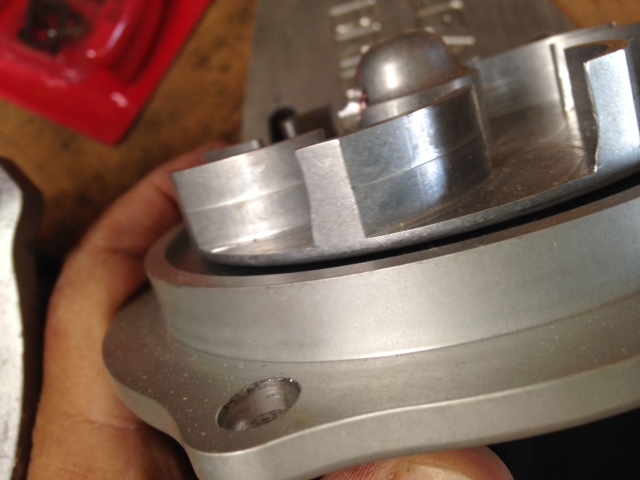
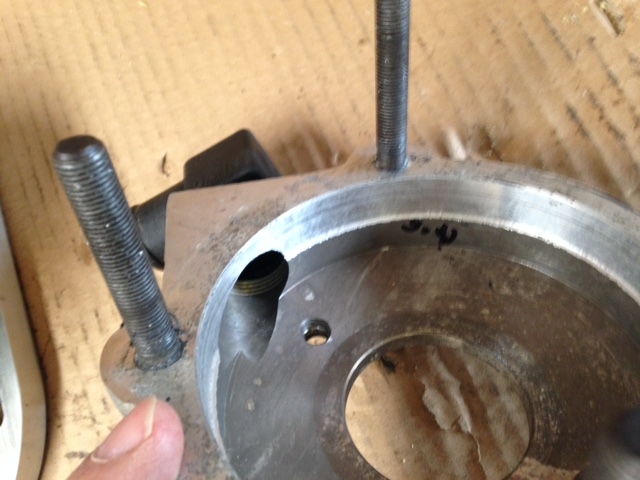
Posted by: BRAVE_HELIOS May 22 2017, 10:24 AM
Finally getting to work on the car. Work travel is killing me.
Have to machine the Renegade pump housing to allow the Jegs unit to fit.
The step on the jegs pump is a little over .500. I machined the housing .600 and enlarged the dia about.030.
Made a mounting bracket and in process of wiring the relays. Will have it come on with Ign. and also tied to the fan switch on the radiator to run after engine is off untill temp comes down.
test running the pump pushes a lot of air out of the system and should help bleeding ?
David



Hi David,
Sorry I haven't called... but I will!
Man I'm rooting for ya... I really hope this works!
Out of curiosity; once you start machining the housing to accept the Jegs pump and for whatever the reason, you decide later to go back to a mechanical setup; will the same housing still work at that point?
Posted by: dwillouby May 22 2017, 10:28 AM
Sure , No problem.
I dont think there will be an issue as the bolts help to align it.
David
Posted by: BRAVE_HELIOS May 28 2017, 03:49 PM
Hey all,
Happy Memorial Day!
I think the car has running much cooler since incorporating the expansion tank out of a v8 Crown Vic. I have taken it for a short drive or two (around 3 miles) with the new setup and it never got past 200. Mind you this is with no T-stat, no rad restrictor washer and straight water for cooling. Fan is configured to come on at 160.
Today; I decided to remove the hood and take it for another drive; this time around 5 miles. Bright sunny day and around 83 degrees out, mixed driving and reaching speeds up to 70 then mostly 40-50. I must say; driving around without a hood garners many looks and thumbs up!
I think removing the hood helped, at least a bit. After my 5 mile loop, the temp was around 190 when I pulled int the garage.
I guess I am having a hard time figuring out what is acceptable for a running temp. I mean if I can keep the temp at 200 or less, even with no t-stat and the fan coming on at 160; I would be happy. If at this time, my setup still has the potential of overheating, what should I do next? Four row radiator? Electric W/P? Both?
See the attached pictures... and back to removing the hood. Like I said; I think it did help in keeping the temp a bit lower but I do not want to drive around with no hood all the time! What about drilling large holes on the front trunk floor to allow more air to escape. Is that feasible? Will it take away from structure rigidity?
Also; if you take a closer look at the picture of the grille versus the length of the radiator, you will notice that the radiator is longer that the grill opening. It is completely sealed and ducted but I wonder if the opening should be larger. I think tomorrow, I will remove the bumper and take it for a drive and see if makes any difference. Stay tuned for more!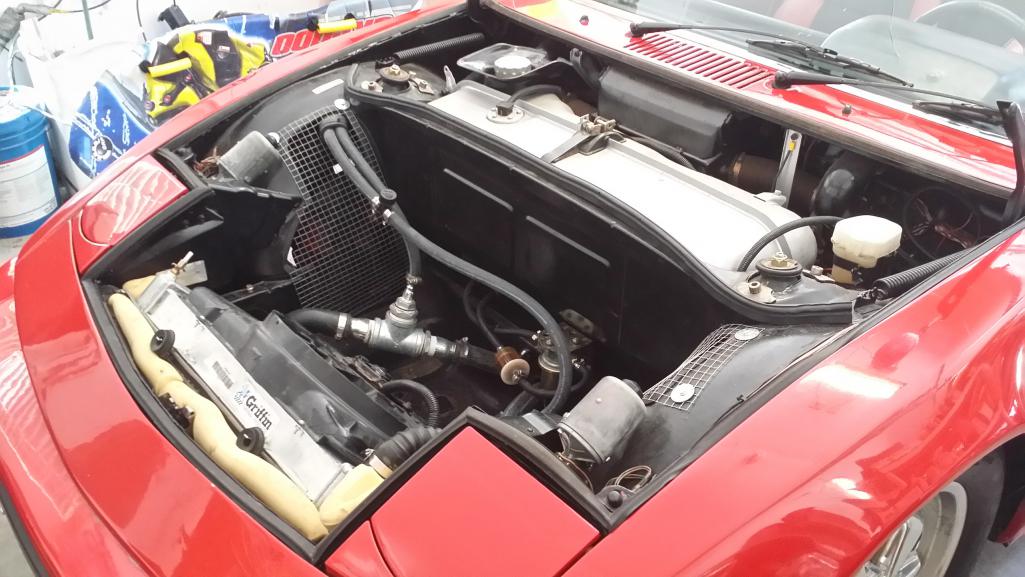
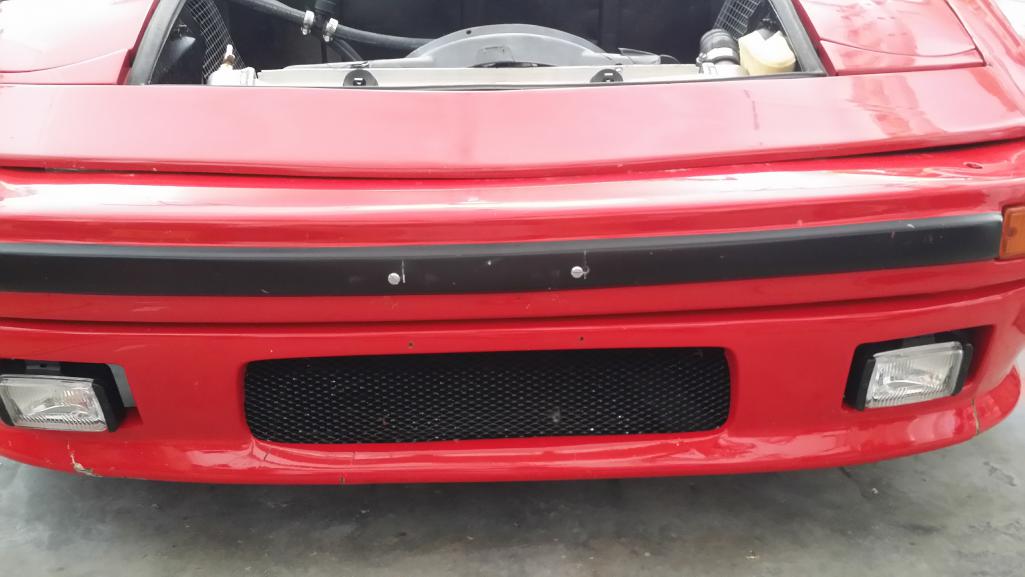
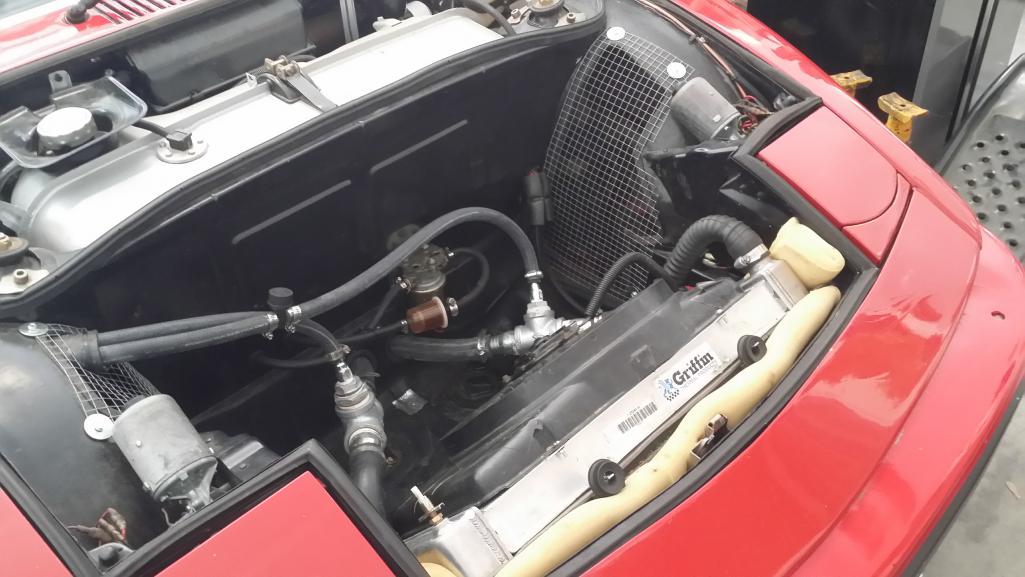
Posted by: Chris914n6 May 28 2017, 04:21 PM
Funny you should say Crown Vic. I worked on a Grand Marquis the other day and thought of you ![]()
It's expansion tank is just a tank with 2 chambers. Feeds from the little hose attached to the top of the rad and returns thru the Tee on the lower return hose/eng intake.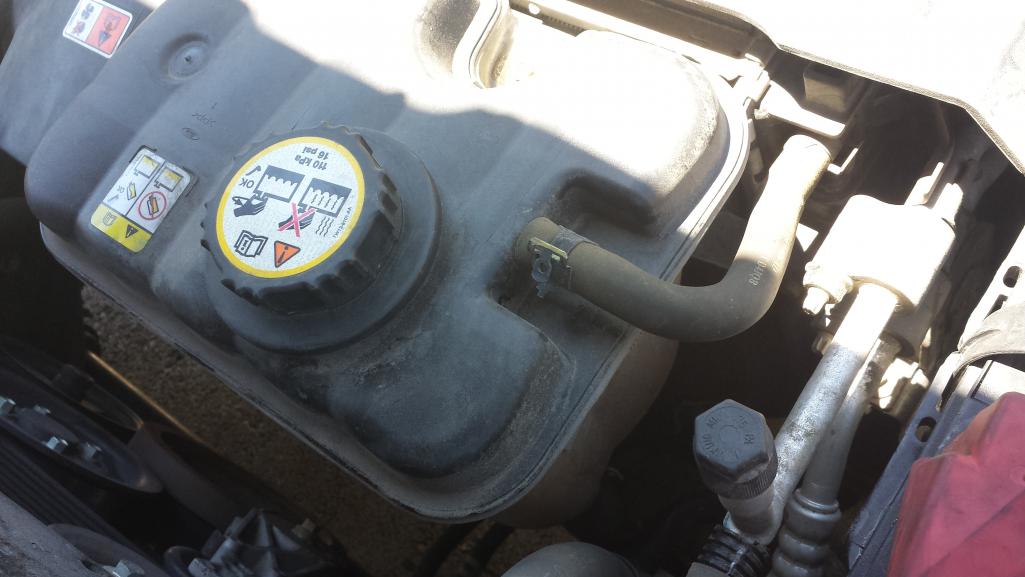
190 is a fine temp for a SBC. The 10 degree drop could be air getting purged with the overnight cool down. You've got 3x the airflow I have and my engine runs at ideal temp so I doubt that's a problem.
Posted by: BRAVE_HELIOS May 28 2017, 04:31 PM
Funny you should say Crown Vic. I worked on a Grand Marquis the other day and thought of you
It's expansion tank is just a tank with 2 chambers. Feeds from the little hose attached to the top of the rad and returns thru the Tee on the lower return hose/eng intake.
190 is a fine temp for a SBC. The 10 degree drop could be air getting purged with the overnight cool down. You've got 3x the airflow I have and my engine runs at ideal temp so I doubt that's a problem.
Lol! Mine looks very much like the one you show except it has the older style twist pressure cap.
I have 3x the airflow because I removed the hood or even with the hood installed? You do not think that drilling large holes in the floor will help with cooling? What type of rad do you have... a 4 core? How about your W/P? Electric or mechanical. Why does your run so cool?
Posted by: Chris914n6 May 28 2017, 09:23 PM
I have 3x the airflow because I removed the hood or even with the hood installed?
hood installed.
Stock mechanical.
VW Corrado with 2 Spal fans to replicate the 2 speed stock fan, back when I first did the conv in 2001. Toyota Celica with stock Celica fans now. I'd say 2 core single pass.
Not a SBC
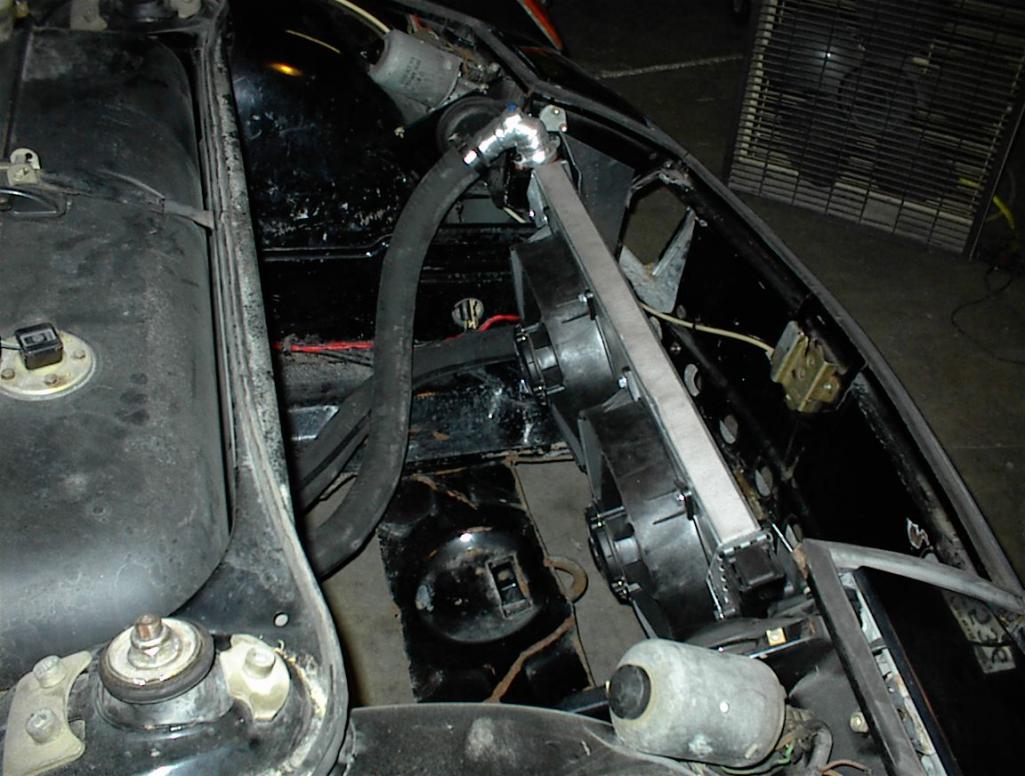
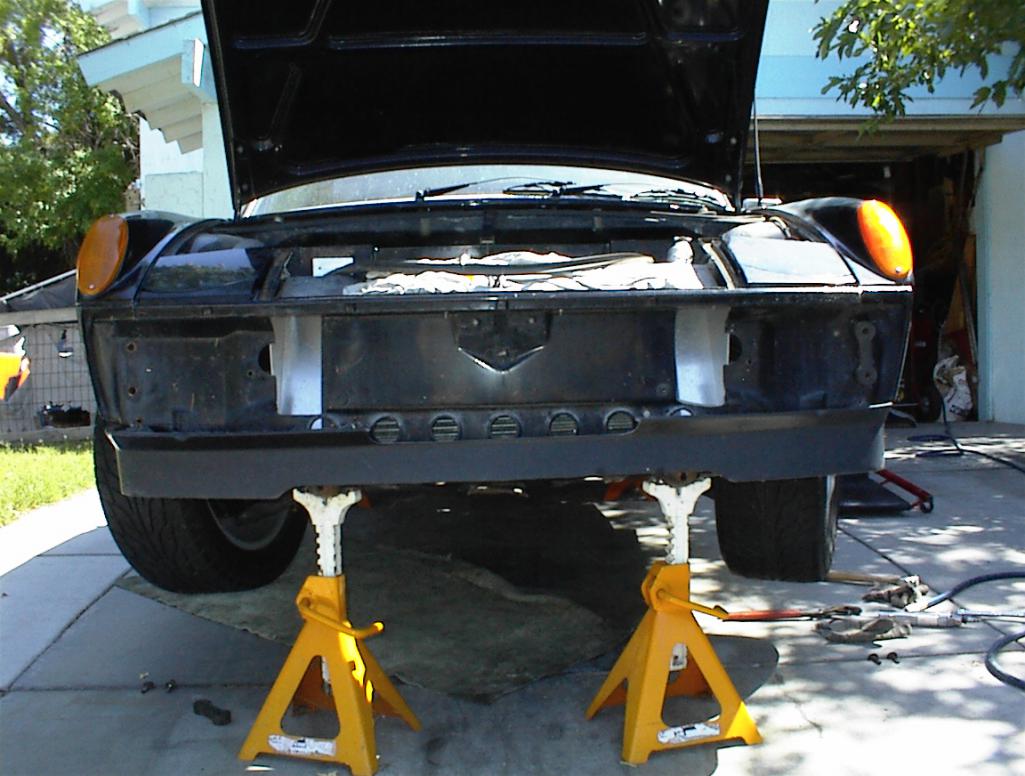
That's it. 2 ugly floor holes from the AC, 5 plugs removed, and 2 holes with deflectors from the horn grilles. The air only expands 20% after heated, NOT 200% as is being sold.
Fun fact. My 180F thermostat starts to open at 180F and reaches full open (~3/8") at 203F. At 203F low speed fan is triggered, at 212F high speed fan is triggered. High speed is rarely triggered but in slow traffic. All controlled by the stock ECU.
Posted by: BRAVE_HELIOS May 29 2017, 01:05 PM
I have 3x the airflow because I removed the hood or even with the hood installed?
hood installed.
Stock mechanical.
VW Corrado with 2 Spal fans to replicate the 2 speed stock fan, back when I first did the conv in 2001. Toyota Celica with stock Celica fans now. I'd say 2 core single pass.
Not a SBC
That's it. 2 ugly floor holes from the AC, 5 plugs removed, and 2 holes with deflectors from the horn grilles. The air only expands 20% after heated, NOT 200% as is being sold.
Fun fact. My 180F thermostat starts to open at 180F and reaches full open (~3/8") at 203F. At 203F low speed fan is triggered, at 212F high speed fan is triggered. High speed is rarely triggered but in slow traffic. All controlled by the stock ECU.
Wow... hardly holey at all!
I wonder; I notice that your rad is angled back versus mine being angled forward. Does that make a difference in air flow? Coolant flow?
Posted by: Andyrew May 29 2017, 01:50 PM
It makes sense in his case since the airflow needs to go down. Yours should be fine as is.
All signs on your setup point to the fact that it should work.
Posted by: BRAVE_HELIOS May 29 2017, 02:28 PM
It was such a nice day; I decided to remove my bumper (as if I didn't have anything better to do!).
I have not taken it out for a drive yet to test cooling but I did want to show you all a a couple of things like the opening in the bulkhead and the rather large (for the Chalon bumper) ducting from the bumper to the bulkhead. Remember... I got that sucker so sealed that the fan will suck in a license plate to the grille!
Do you think the bulkhead opening is large enough? I can probably remove those two rubber plugs to add a bit more to the air flow. What about the grille opening on the bumper... it is around 21 inch by 5 inch. Is it a sufficient size for the cooling?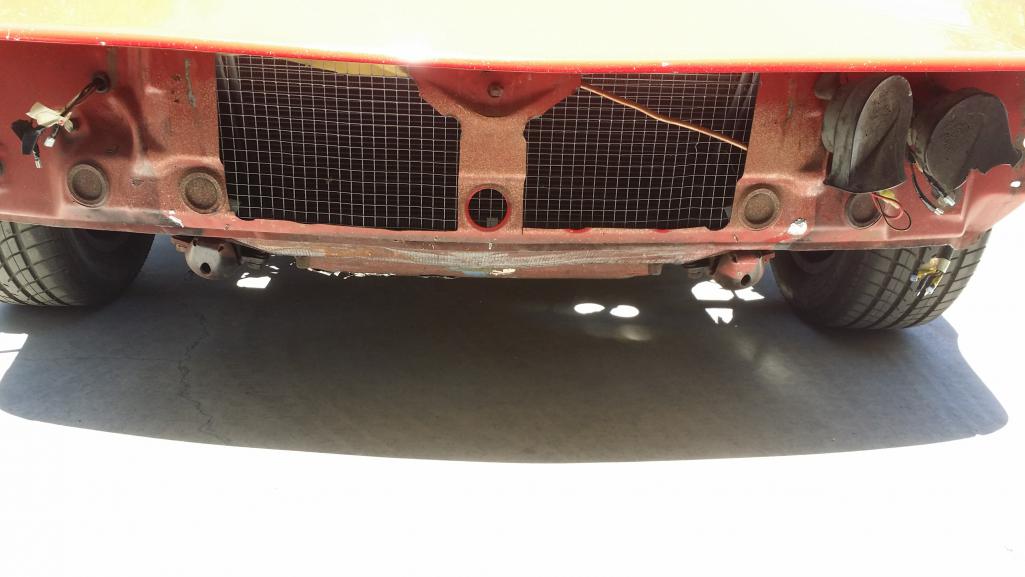
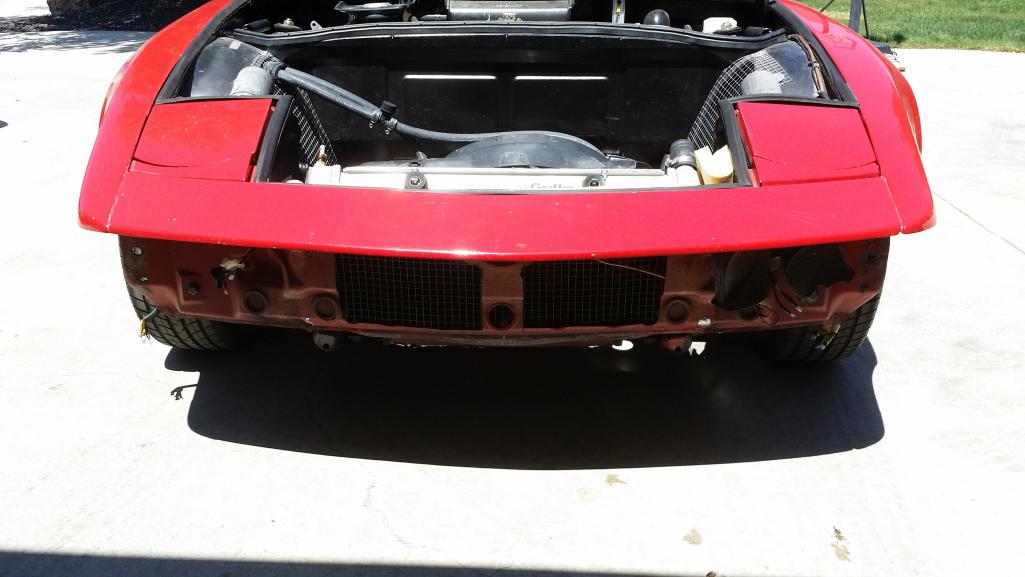
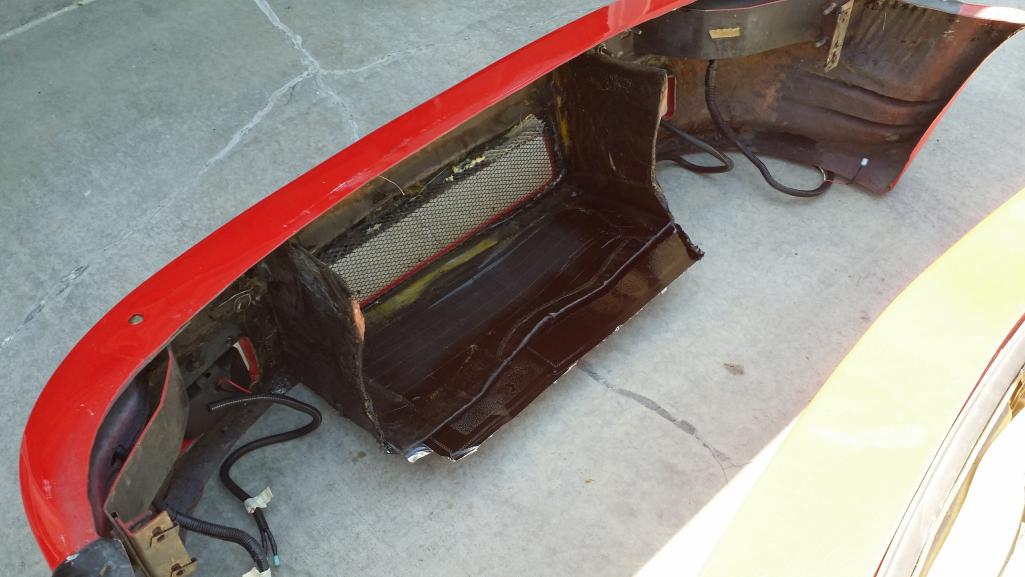
Posted by: burton73 May 29 2017, 06:45 PM
My 1st 914-V8 back in 1979 had a 916 fiberglass front end that had a smaller opening than you show on your car. It only had fender openings the size of yours. The car was flared with 8-inch wheels up front. It had a aluminum radiator from a Corvette leaned at an angle so it would fit in the car and I made a sheet metal shroud for it and it used one large Jaguar fan. Nothing that fancy. This was back in 1979 when a V8 in a Porsche was somewhat rare. Not a big HP car just a 283 with carb and cam and headers. Trying to understand your airflow and comparing it to my old car.
I ran gates green stripe water hoses through the heater tubes, a Rob Simpson water pump housing and water pump from what I remembered was from a Mopar Big Block. The sealing on the shroud was not that great and a lot of air flower around the radiator as well as I remember that the car got hot inside as well from the hot air. I drove it with the top off or the windows down, I did not run a thermostat on it.
It did not run cool but 200F or so was what I remember as the norm for it.
This was in Los Angeles area.
Not sure if you are chasing what may not happen in your car. I would not cut anymore metal out of your car.
Bob B
![]()
Posted by: BRAVE_HELIOS May 31 2017, 08:43 PM
This evening, I finally had a chance to take the car out for drive without the hood and the front bumper. Temperature was around 80; skies were cloudy (minimal sunshine); winds at around 9 mph from the north and 30% humidity.
What can I say... this was the longest I drove my car (around 10 miles with speeds approaching 60 but mostly in the 40s and 50s) and the temp never went beyond 185! Usually, I would drive half that distance and my temp would be closer to 200 or higher.
I believe I can honestly say that I've narrowed down the run hot issue to either not enough air passing through the radiator or not enough air exiting the radiator and front hood cavity via the inner fender walls. It might even be a combination of both.
If the restriction is on the inlet side, I do not know how I can increase the area of the grille opening without hacking up the Chalon front bumper. Any tips/ideas?
If the restriction is on the exhaust side, the inner fender walls have been opened up to their max size. I suppose the next logical thing to do is allow more air to escape via the floor of the trunk... drill some large size holes? Next might be to louver the hood itself.
I have not completely dismissed the idea of going to an electric water pump and I do want to hear back from David to see how his Jegs electric WP mounted in his remote WP housing works out, but my testing and results are also hard to ignore and right now it looks like the problem is air flow in and/or out of the radiator!
Discuss, discuss then speak up! ![]()
Thanks!
Posted by: Andyrew May 31 2017, 09:44 PM
This evening, I finally had a chance to take the car out for drive without the hood and the front bumper. Temperature was around 80; skies were cloudy (minimal sunshine); winds at around 9 mph from the north and 30% humidity.
What can I say... this was the longest I drove my car (around 10 miles with speeds approaching 60 but mostly in the 40s and 50s) and the temp never went beyond 185! Usually, I would drive half that distance and my temp would be closer to 200 or higher.
I believe I can honestly say that I've narrowed down the run hot issue to either not enough air passing through the radiator or not enough air exiting the radiator and front hood cavity via the inner fender walls. It might even be a combination of both.
If the restriction is on the inlet side, I do not know how I can increase the area of the grille opening without hacking up the Chalon front bumper. Any tips/ideas?
If the restriction is on the exhaust side, the inner fender walls have been opened up to their max size. I suppose the next logical thing to do is allow more air to escape via the floor of the trunk... drill some large size holes? Next might be to louver the hood itself.
I have not completely dismissed the idea of going to an electric water pump and I do want to hear back from David to see how his Jegs electric WP mounted in his remote WP housing works out, but my testing and results are also hard to ignore and right now it looks like the problem is air flow in and/or out of the radiator!
Discuss, discuss then speak up!
Thanks!
You need to do scientific testing.
Map a route, Determine OUtside air temps. Drive route without bumper or hood, Then drive it same temp without hood only, and finally without bumper only.
This will ID where your problem is.
Posted by: burton73 May 31 2017, 10:13 PM
I was just looking at your build thread and question the airflow from the front. Have you tried removing the front license plate? If that helps you may also open up some of the fiberglass on the bottom of your bumper and see if that helps with more airflow. If I remember the front of the Chalon kit was formed from a 74 on front 911bumper and a turbo bottom valance rubber trim.
Not sure that you showed us the amount of metal removed on the factory 914 nose.
It seams that you need flow based on in flow through the front and out flow through the fenders, see what the sq. inches of cut outs you have leaving and SQ inches of cut outs for inflow. Somewhere there is back pleasure where it is not flowing. I do not think opening up more holes in the fenders will help you.
Bob B
Posted by: BRAVE_HELIOS Jun 1 2017, 09:10 AM
I was just looking at your build thread and question the airflow from the front. Have you tried removing the front license plate? If that helps you may also open up some of the fiberglass on the bottom of your bumper and see if that helps with more airflow. If I remember the front of the Chalon kit was formed from a 74 on front 911bumper and a turbo bottom valance rubber trim.
Not sure that you showed us the amount of metal removed on the factory 914 nose.
It seams that you need flow based on in flow through the front and out flow through the fenders, see what the sq. inches of cut outs you have leaving and SQ inches of cut outs for inflow. Somewhere there is back pleasure where it is not flowing. I do not think opening up more holes in the fenders will help you.
Bob B
Hey Bob,
Good questions!
Removing the license plate was one of the first things I did and I think it helped a bit... perhaps more than a bit but there were other things going on too.
I followed the Renegade manual in regards to opening area versus exiting area (I do not have the numbers but I will get them later) and was able to meet the recommendations.
I think I can open up the bottom of the Chalon bumper but need to really look at to see if I can duct it to the bulkhead correctly.
I'll get that info this evening.
Posted by: Chris914n6 Jun 1 2017, 03:12 PM
I followed the Renegade manual in regards to opening area versus exiting area (I do not have the numbers but I will get them later) and was able to meet the recommendations.
If you have the same setup as everyone else then that's not your problem. You are either generating more heat in the engine (running lean) or you are still burping the system.
First put the hood back on and go for a drive then report back. Next day put the bumper back on and report back.
I did some work on a 2000 Jeep Grand Cherokee yesterday. The car idled at a steady 200f without the fan even on. It needs to be asked, what temp do you think is right for your 914?
Posted by: BRAVE_HELIOS Jun 1 2017, 04:00 PM
I followed the Renegade manual in regards to opening area versus exiting area (I do not have the numbers but I will get them later) and was able to meet the recommendations.
If you have the same setup as everyone else then that's not your problem. You are either generating more heat in the engine (running lean) or you are still burping the system.
First put the hood back on and go for a drive then report back. Next day put the bumper back on and report back.
I did some work on a 2000 Jeep Grand Cherokee yesterday. The car idled at a steady 200f without the fan even on. It needs to be asked, what temp do you think is right for your 914?
Hey Chris,
I understand... I am quite certain that my setup is similar to what others have (perhaps even a bit better) and I have tried to follow the Renegade manual, and that is why I am struggling with this. On one hand, I have parts of the Renegade Kit like the WP housing and the mechanical BB Chrysler which should work... they are from the kit manufacturer! On the other hand; it seems that many of the owners of similar conversions have switched over to electric WP's for the same reasons and concerns I am having.
I have a mild cam installed with headers, dual plane aluminum intake and a 650 cfm carb. I do not think it is running lean... the exhaust tips have black soot and on them and my gas mileage is really bad... like very low teens to perhaps even high single mpg's.
What is a normal operating temp for my car? IDK. SBC do not like anything above 230 degrees and mine has been there there or awfully close many times in the past. I start to get worried whenever it goes past 210 (sensor is installed in intake port right next to t-stat).
Perhaps now that the expansion tank is working correctly; I have not given it enough time/cycles to correctly burp the system.
That was my thought process... start with re-installing the hood and see what it does, then move on to re-installing the bumper. I'll let you know what I find!
Posted by: BRAVE_HELIOS Jun 1 2017, 10:15 PM
So with the hood and the bumper off, I decided to remeasure all of my openings to make sure they matched what Renegade recommends. Although Renegade does not make a recommendation for the bumper opening, they do recommend a minimum of one square foot opening for the front panel. I suppose the same recommendation would apply to the bumper opening too. On the outlet side of things, Renegade recommends a minimum of 120 square inches per inner fender opening (side). My Renegade manual is dated July 1990.
My measurements? Well, my grille opening is a measly 105 sq inches (around 0.73 sq foot)... below Renegade's minimum. My front panel opening comes out to 158.63 sq inches (1.1 sq foot) which is slightly over minimum and the outlet areas are 154.25 and 144 sq inches respectively... again slightly more than recommended by Renegade.
It would appear that on paper anyway, my weak link/bottle neck might be my grille opening size. It is also the hardest part to open up and still have it look decent.
I did notice that where my opening on the front panel is strictly on the vertical surface, Renegade did open theirs below the vertical side... and cut into the floor/horizontal surface. I need more grille opening area!
Posted by: Chris914n6 Jun 1 2017, 11:49 PM
My Renegade manual is dated July 1990.
My air inlet is 97 sqin and actually over cools at highway speeds.
You need to go test it with hood on bumper off before coming to conclusions.
I thought the car did 190 with the new bottle?
What are the temps at idle, stop n go, and freeway? Each scenario is a different condition.
I used to do engineering for RH. I didn't get lucky, I actually crunched the airflow numbers.
Posted by: BRAVE_HELIOS Jun 2 2017, 08:52 AM
My Renegade manual is dated July 1990.
My air inlet is 97 sqin and actually over cools at highway speeds.
You need to go test it with hood on bumper off before coming to conclusions.
I thought the car did 190 with the new bottle?
What are the temps at idle, stop n go, and freeway? Each scenario is a different condition.
I used to do engineering for RH. I didn't get lucky, I actually crunched the airflow numbers.
Nice!
Anyone have a newer Renegade manual they would like to share?
195 max (so far) with the new bottle and hood/bumper installed.
Last night; I looked at my overflow bottle and the system actually drew some water back in after my drive without the hood and bumper 2 nights ago. I don't think it sucked in any air but it did get kind of low. Looks like the dang system is finally working!
This weekend is supposed to be in the 90's. I'll start by installing the hood and taking it for a ride (of course jot down all pertinent info) and let's see what we find!
Posted by: BRAVE_HELIOS Jun 10 2017, 10:17 AM
After carefully inspecting my radiator area, I made an observation and am now wondering the affects of having my rad set up the way it is. Notice that I have the rad positioned with the top of it resting pretty much against the front panel (resting on a flat bar going across the top). Seemed an easy way to mount it. But; I have noticed most others mount theirs so that the top of the rad is resting further back and away from the front panel. Most then create a cover/shroud to cover that top space. Mine has no space on the top side of the rad, between the front panel and the rad. Would that extra space on the top side of the rad be beneficial to the cooling efficiency of the system... perhaps acting as a cooling plenum or chamber?
Here in Boyzee; I've either been busy at work or it's been downright cool during the days so it's been hard for me to test during a hot day. For example right now; it's cloudy and it's in the high 50's and it's even snowing in the Sawtooth's... go figure.
I want want to perform my driving tests but I also want to put the bumper back on but what about the radiator positioning like I mentioned above; is their any validity in the observation? 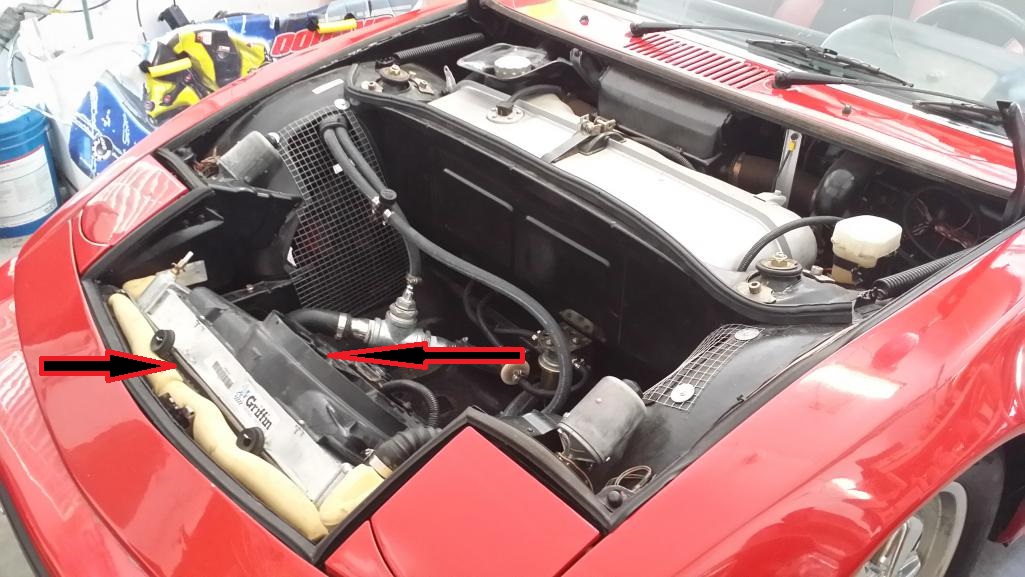
Posted by: Andyrew Jun 10 2017, 10:29 AM
I had my radiator setup the same way (Tilted forwards) and didnt have overheating issues from it.
Mike Bellis had his radiator laying flat against the floor on his old v8 car...
Posted by: Chris914n6 Jun 10 2017, 08:48 PM
Nice!
Anyone have a newer Renegade manual they would like to share?
195 max (so far) with the new bottle and hood/bumper installed.
Last night; I looked at my overflow bottle and the system actually drew some water back in after my drive without the hood and bumper 2 nights ago. I don't think it sucked in any air but it did get kind of low. Looks like the dang system is finally working!
This weekend is supposed to be in the 90's. I'll start by installing the hood and taking it for a ride (of course jot down all pertinent info) and let's see what we find!
Your rad position is fine. The Corvette and 300zx actually lay flatter.
195 is fine.
Water expands when hot & shrinks when cool, so the reservoir is supposed to get fuller and return to the starting level. If it keeps getting lower and lower you are still burping air or you've got a leak. With the 914s funky hi-lo-hi system it's not uncommon to top off several times after the first dozen drives.
Posted by: BRAVE_HELIOS Jun 11 2017, 09:09 AM
Nice!
Anyone have a newer Renegade manual they would like to share?
195 max (so far) with the new bottle and hood/bumper installed.
Last night; I looked at my overflow bottle and the system actually drew some water back in after my drive without the hood and bumper 2 nights ago. I don't think it sucked in any air but it did get kind of low. Looks like the dang system is finally working!
This weekend is supposed to be in the 90's. I'll start by installing the hood and taking it for a ride (of course jot down all pertinent info) and let's see what we find!
Your rad position is fine. The Corvette and 300zx actually lay flatter.
195 is fine.
Water expands when hot & shrinks when cool, so the reservoir is supposed to get fuller and return to the starting level. If it keeps getting lower and lower you are still burping air or you've got a leak. With the 914s funky hi-lo-hi system it's not uncommon to top off several times after the first dozen drives.
I put the bumper back on yesterday and drove it for a while and it stayed at around 185. It was a cool day... around 70 when I drove it.
Assuming things will slowly get better as you mention; it begs the question... how many out there continue to use a mechanical pump and how many have switched to electric and why the change over.
Posted by: sb914 Jun 11 2017, 09:44 AM
I had same issues.car would shoot up to 200-210 within 10 minutes I would bet your whole issue is trapped air.not shrouding!
Once I got my "air" issue fixed I haven't had a problem since!
Runs about 180 -185 all day!
And I burp it frequently. ![]()
Posted by: 914GT Jun 11 2017, 09:45 AM
I've had a remote electric pump since I built the car in 2002. Went that way for a few reasons. There were claims an electric pump would not work so I like a challenge. And at the time I could go with an electric pump for less money then a belt-drive pump. Finally, the electric pump offers more flexibility on location and simplifies things by eliminating the brackets and hardware needed for a belt drive pump. I've been very happy with it and no problems after 15 years.
Posted by: dwillouby Jun 13 2017, 11:38 AM
Got to work on the car last weekend. Just returned from China. Still have jet lag so didnt work too hard. Finished the wiring and took it out for a test drive. Temps were in the high 80s. On open road temps were 170-180. Setting in traffic after drive temps got to about 205. Still havent really purged the air completely. I feel the Jegs pump so far works as well or better than the Renagade pump.
David
Posted by: BRAVE_HELIOS Jun 13 2017, 12:30 PM
Got to work on the car last weekend. Just returned from China. Still have jet lag so didnt work too hard. Finished the wiring and took it out for a test drive. Temps were in the high 80s. On open road temps were 170-180. Setting in traffic after drive temps got to about 205. Still havent really purged the air completely. I feel the Jegs pump so far works as well or better than the Renagade pump.
David
David,
Welcome back and glad it's working out so well so far. Let us know how it goes after a few run cycles.
It's been cold and rainy here, pretty hard to test hot weather performance. Funny thing is usually around this time of year, it's like 100 degreed out, no clouds and very little humidity. Darn El Ninia!
Posted by: Chris914n6 Jun 13 2017, 03:06 PM
Got to work on the car last weekend. Just returned from China. Still have jet lag so didnt work too hard. Finished the wiring and took it out for a test drive. Temps were in the high 80s. On open road temps were 170-180. Setting in traffic after drive temps got to about 205. Still havent really purged the air completely. I feel the Jegs pump so far works as well or better than the Renagade pump.
David
Around 20-30mph the airflow from moving becomes greater than the airflow from the fans. Might not be air bubbles but an insufficient fan cfm. Still, 205f is not a deadly number.
Posted by: BRAVE_HELIOS Jun 13 2017, 09:29 PM
Got to work on the car last weekend. Just returned from China. Still have jet lag so didnt work too hard. Finished the wiring and took it out for a test drive. Temps were in the high 80s. On open road temps were 170-180. Setting in traffic after drive temps got to about 205. Still havent really purged the air completely. I feel the Jegs pump so far works as well or better than the Renagade pump.
David
Around 20-30mph the airflow from moving becomes greater than the airflow from the fans. Might not be air bubbles but an insufficient fan cfm. Still, 205f is not a deadly number.
Chris, You may have mentioned this earlier but do you run a mechanical or electric WP?
Posted by: dwillouby Jun 14 2017, 07:53 AM
I will try to purge the air better this weekend. I have the complete Renagade system so I think the fans are rated correctly. What I dont have is shrouding around the fans. They didnt do it when I bought the system . May mock up a shroud as well and see what happens.
David
Posted by: BRAVE_HELIOS Jun 30 2017, 05:15 PM
I will try to purge the air better this weekend. I have the complete Renagade system so I think the fans are rated correctly. What I dont have is shrouding around the fans. They didnt do it when I bought the system . May mock up a shroud as well and see what happens.
David
Dave... update please! What are the results of your upgrade so far?
As for me... so far so good. Drove it to work (10 miles one way) and back and it barely broke 200 and it was a warm day too!
Posted by: TC 914-8 Jul 17 2023, 03:17 PM
I see this thread is several years old. I’m just curious if this ever worked out with the electric water pump does anybody have any input? ![]()
Posted by: dwillouby Jul 18 2023, 08:20 AM
Best location is the lowest point in the cooling system and at the rear (below engine). During acceleration the suction side of the pump will have highest pressure and helps the pump when you need maximum flow.
So then my idea of using the Jegs pump and mounting it the Renegade remote water pump housing is a good idea (as long as clearance allows)?
Used the Jegs pump with my Renegade housing. Had to machine the housing (.100 ?) to allow the pump to fit.
Changed to Mezier with the LS.
Posted by: burton73 Jul 18 2023, 08:35 PM
I see this thread is several years old. I’m just curious if this ever worked out with the electric water pump does anybody have any input?
http://www.914world.com/bbs2/index.php?showtopic=363404
Here is an example of electric water pump.
As well as a V8 car for sale from one of our fine members
Bob B
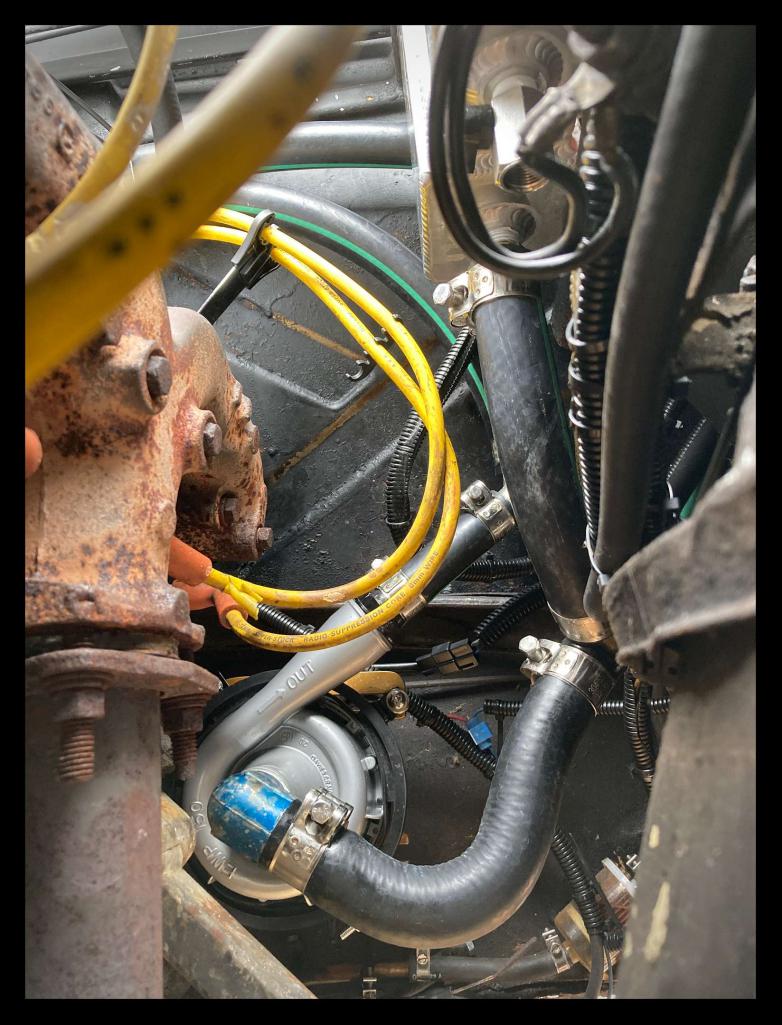
Posted by: TC 914-8 Jul 19 2023, 07:35 AM
Best location is the lowest point in the cooling system and at the rear (below engine). During acceleration the suction side of the pump will have highest pressure and helps the pump when you need maximum flow.
So then my idea of using the Jegs pump and mounting it the Renegade remote water pump housing is a good idea (as long as clearance allows)?
Used the Jegs pump with my Renegade housing. Had to machine the housing (.100 ?) to allow the pump to fit.
Changed to Mezier with the LS.
Thanks for the reply, when you did run the Jegs unit did you have enough flow or any cooling issues ?
Posted by: TC 914-8 Jul 19 2023, 07:49 AM
I see this thread is several years old. I’m just curious if this ever worked out with the electric water pump does anybody have any input?
http://www.914world.com/bbs2/index.php?showtopic=363404
Here is an example of electric water pump.
As well as a V8 car for sale from one of our fine members
Bob B

Looks good Bob, I have heard the Davies-Craig is a good option, I’m trying to retrofit without any major reworking of the system. My current belt driven unit works fine but I know the Rod Simpson housing has a restricted inlet. I’ve reached out to Renegade to see if they will sell a housing I can use the Jegs electric motor. I’m also trying not to create more problems by messing with the already functioning system.
Posted by: dwillouby Jul 19 2023, 07:52 AM
Best location is the lowest point in the cooling system and at the rear (below engine). During acceleration the suction side of the pump will have highest pressure and helps the pump when you need maximum flow.
So then my idea of using the Jegs pump and mounting it the Renegade remote water pump housing is a good idea (as long as clearance allows)?
Used the Jegs pump with my Renegade housing. Had to machine the housing (.100 ?) to allow the pump to fit.
Changed to Mezier with the LS.
Thanks for the reply, when you did run the Jegs unit did you have enough flow or any cooling issues ?
Yes if I recall it worked better as didn't depend on engine speed for flow rate.
Didnt use very long as was in process of upgrading to the LS renegade system
Posted by: TC 914-8 Jul 19 2023, 10:21 AM
Best location is the lowest point in the cooling system and at the rear (below engine). During acceleration the suction side of the pump will have highest pressure and helps the pump when you need maximum flow.
So then my idea of using the Jegs pump and mounting it the Renegade remote water pump housing is a good idea (as long as clearance allows)?
Used the Jegs pump with my Renegade housing. Had to machine the housing (.100 ?) to allow the pump to fit.
Changed to Mezier with the LS.
Thanks for the reply, when you did run the Jegs unit did you have enough flow or any cooling issues ?
Yes if I recall it worked better as didn't depend on engine speed for flow rate.
Didnt use very long as was in process of upgrading to the LS renegade system
Thanks !!! Any chance you still have the Renegade housing ? For sale ?
Posted by: burton73 Jul 19 2023, 12:54 PM
Best location is the lowest point in the cooling system and at the rear (below engine). During acceleration the suction side of the pump will have highest pressure and helps the pump when you need maximum flow.
So then my idea of using the Jegs pump and mounting it the Renegade remote water pump housing is a good idea (as long as clearance allows)?
Used the Jegs pump with my Renegade housing. Had to machine the housing (.100 ?) to allow the pump to fit.
Changed to Mezier with the LS.
Thanks for the reply, when you did run the Jegs unit did you have enough flow or any cooling issues ?
Yes if I recall it worked better as didn't depend on engine speed for flow rate.
Didnt use very long as was in process of upgrading to the LS renegade system
Thanks !!! Any chance you still have the Renegade housing ? For sale ?
I clearly remember the rod Simpson water pump housing. This was back in 1979, it fit a 440 or big block Mopar water pump some guys said they had to the machine the back a little bit because when you pushed a stock water pump in, the back of it was hitting the back wall of housing. It needed to be clearanced a little. My memory, that of a 70 year old dude
Best Bob B Burton
Powered by Invision Power Board (http://www.invisionboard.com)
© Invision Power Services (http://www.invisionpower.com)
